
archives for 08/2013
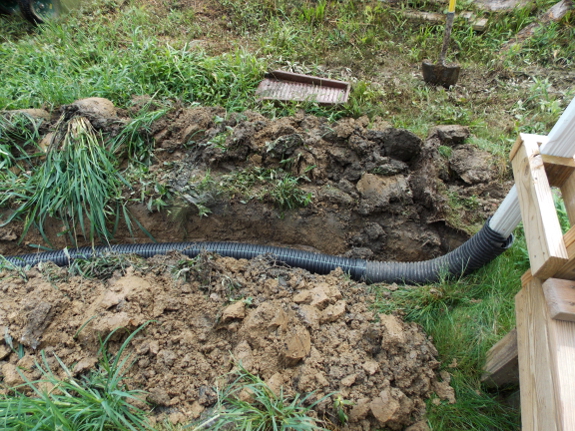
A body of water
that's kept full by rain alone, with no spring or stream flowing
in, is known as a sky pond. Our experimental
pond is going
to be filled by roof-overflow, so it's a sky pond, but one that
needs an inlet pipe.
Since the
pond
is located in the area that used to be a swamp due to said
roof-overflow,
it was a simple matter to pipe the water downhill into the
pond. I dug a shallow trench, fitted a piece of corrugated
plastic pipe around the gutter outlet, and ran the pipe down to
the pond. Mom had picked up a three-foot piece of corrugated
pipe by the side of the road a couple of months ago, which
combined with a ten-foot, purchased length to go right to the edge
of the pond depression. (Thanks for bringing me just what I
needed, Mom!)
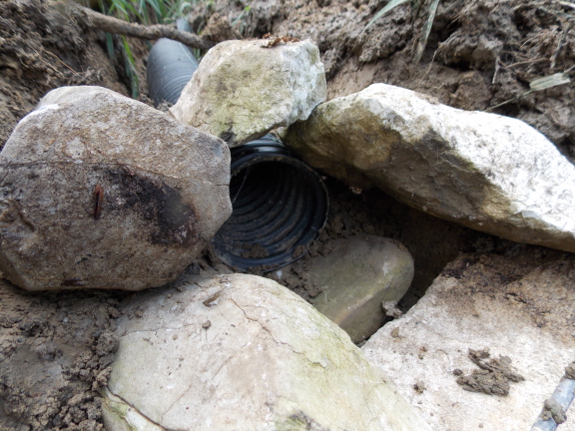
As with our greywater
wetland, I
didn't want the inflow of water to erode away my bank, so I lined
the entrance with stones. Then I covered up the pipe, and
sat back to wait for rain. (This seems to be the surefire
way to dry up a soppy summer --- the watched rain cloud never
forms.)
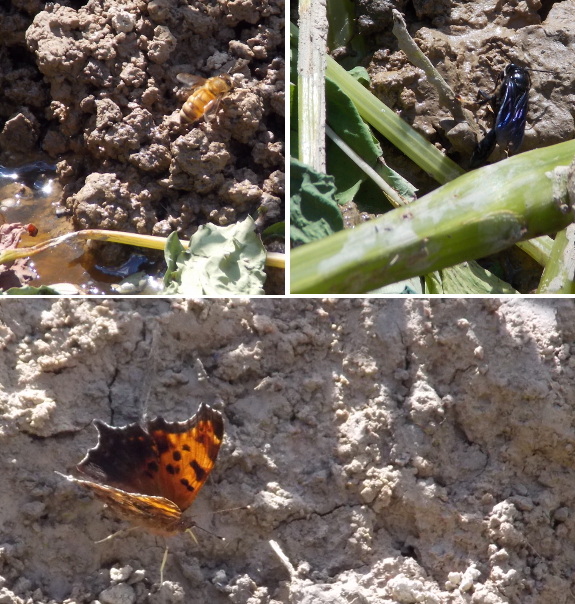
While I bided my time
until the sky pond filled, I kept an eye on the
gleying process. Earth
Ponds reports
that it may take up to two weeks for gleying to take effect (with
total sealing of an earth pond sometimes requiring two years), but
I could tell something was already happening...by smell.
Yep,
the pond developed a quite-distinctive fermentation odor, which
attracted all kinds of winged critters. (To be fair, some
of them might have just been dropping by to drink from the open
water.) The smell wasn't terrible, but I'd hesitate to
reproduce this procedure in a small city lot with nosy neighbors
next door. Good thing our closest neighbor is half a mile
away.
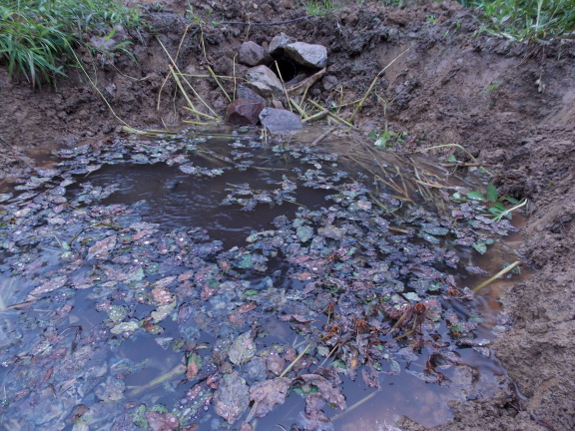
And then the rain
came! It was a gentle shower, dropping no more than half an
inch of water, but the sky pond filled up fast. Eventual
depth at the deepest point was 13.25 inches.
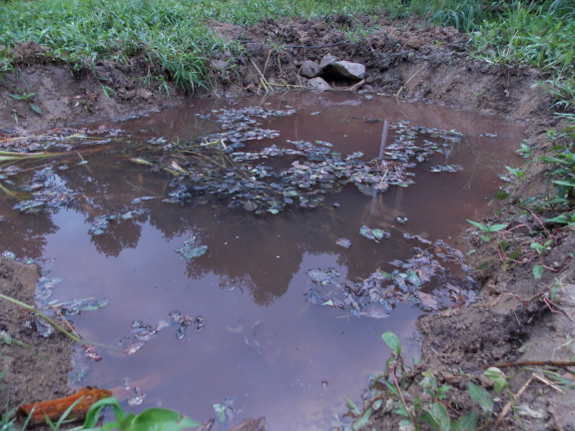
We ran out of rain
before we ran out of water-holding capacity, but I can tell I'm
going to have to hook up the overflow and dig the secondary pond
sooner rather than later. In the meantime, I'm curious to
see whether the pond sinks down to its groundwater level quickly
or whether it holds onto this rain.
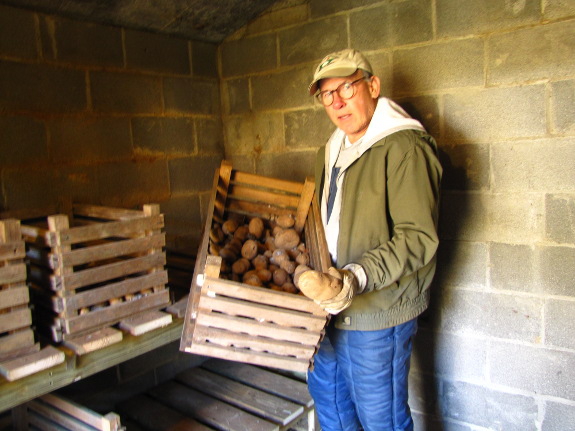
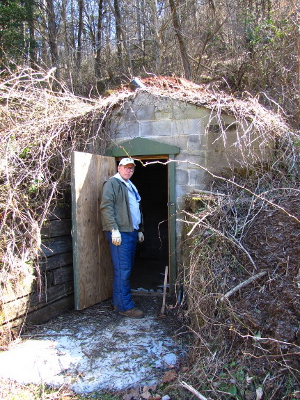 Our neighbor, Frank Hoyt Taylor, took
advantage of the backhoe rented by a friend for grading a
house site to dig a root cellar into his north-facing
hillside. When the excavation was completed, it became
clear that Frank had opened a hole into a cave, so he decided
to gain some extra geothermal cooling by running pipes from
the back of his root cellar into the cave.
Our neighbor, Frank Hoyt Taylor, took
advantage of the backhoe rented by a friend for grading a
house site to dig a root cellar into his north-facing
hillside. When the excavation was completed, it became
clear that Frank had opened a hole into a cave, so he decided
to gain some extra geothermal cooling by running pipes from
the back of his root cellar into the cave.As with Emily's basement cut-off, I'm going to refer you to $10 Root Cellar if you want to read all of Frank's construction tips. That way, I'll have room in this post to sum up his results.
The weakest link in Frank's root cellar is the front wall and door, both of which are open to the elements (although insulated with foamboard). Ice does occasionally form on the inside of the exposed front wall, but temperatures in the main root cellar stay steady for most of the year between 50 and 55 degrees.
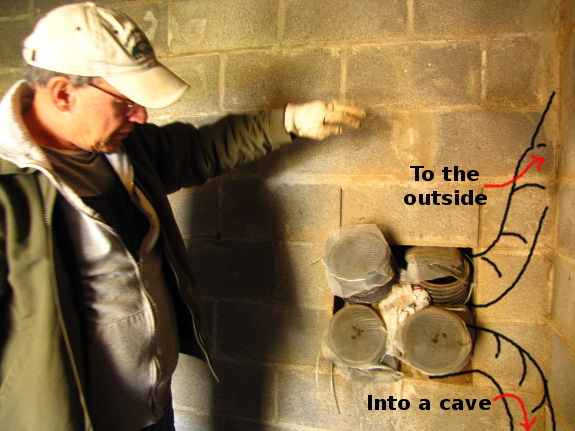
The real beauty of
Frank's root cellar is the way he has created a very low-budget
geothermal system by tapping into a naturally-occurring
cave. The cool-air intake involves four drainage-tile pipes,
two of which go directly to the outside and two of which dip into
the cave. Unfortunately, the outside-air pipes were crushed
when the backhoe pushed soil 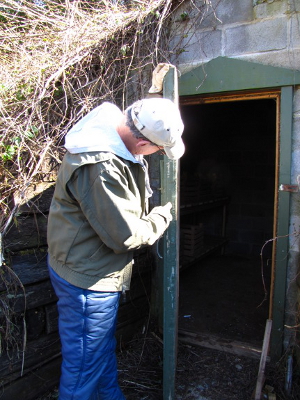 up against the back of the root cellar, so
Frank feels the root cellar could benefit from more
ventilation. He is considering adding vents at the bottom of
the wooden door, but is happy with the outlet vent at the top of
the cellar.
up against the back of the root cellar, so
Frank feels the root cellar could benefit from more
ventilation. He is considering adding vents at the bottom of
the wooden door, but is happy with the outlet vent at the top of
the cellar.
Frank built the root
cellar with the help of his friend Jim around 2003. The pair
didn't keep track of their labor (which was extensive) and didn't
have to pay for the backhoe since it was already on-site.
Those caveats aside, they estimate they built their cave root
cellar for about $200.
Frank enjoys the way
cave salamanders share space with homegrown potatoes, and he notes
that the structure could double as a tornado shelter if
necessary. When the backhoe-driver came to check up on the
cellar a few months after construction, he opined "That root
cellar is worth a fortune," and Frank agrees.
| This
post is part of our $10
Root Cellar lunchtime series.
Read all of the entries: |
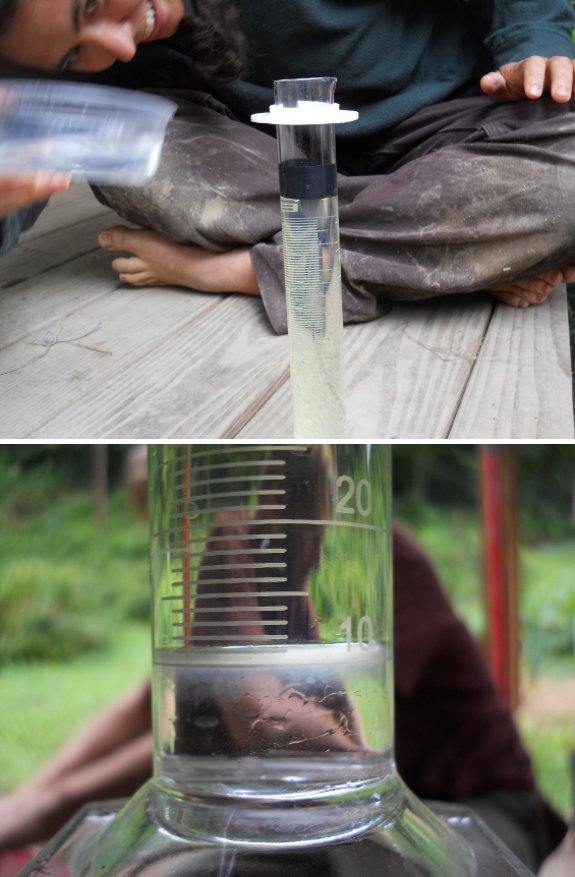
We got this 100
mL graduated cylinder on
Amazon for 12 dollars to do some fuel testing.
Anna has some lab experience
and talked me into the glass model for twice the money.
The first test was done on
some premium fuel I got at the Food City in St Paul.
Food City uses Ethanol like
everybody else and the results showed the advertised 10%, but that was
just to get us accustomed to the procedure. We plan to do the next test
on some so called "Ethanol Free" fuel that a few stations around here
claim to sell.
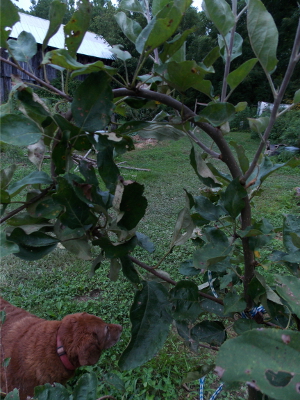 What do you do if you have a dwarf apple tree
that comes down with fire
blight, you're forced to prune it radically, then it
responds by sending up masses of water sprouts? One website
recommended tying the water sprouts into loops to make the tree
fruit next year instead of zooming further upright.
What do you do if you have a dwarf apple tree
that comes down with fire
blight, you're forced to prune it radically, then it
responds by sending up masses of water sprouts? One website
recommended tying the water sprouts into loops to make the tree
fruit next year instead of zooming further upright.
This particular dwarf
is the oldest perennial we have on the farm, but has yet to give
me a single flower. It's been my learning tree in a lot of
ways, and has the growing pains to prove it. I started the
tree in the mule garden, transplanted it out when we moved the
mules in, then didn't realize that dwarf trees need
a lot of TLC if you want them to bear.
So these loops are my
last-ditch effort to save a very troubled tree who should have
been producing years ago. The loops are certainly
interesting, whether they work or not!
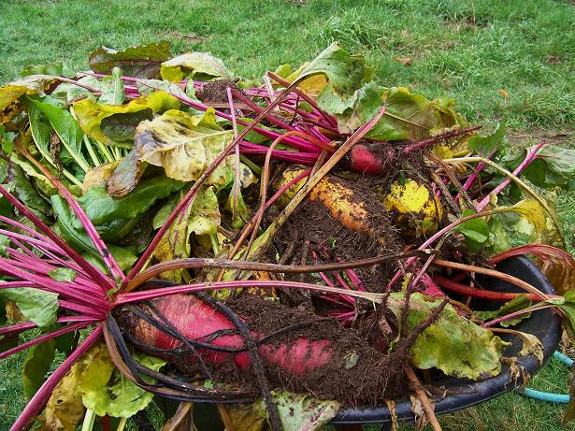

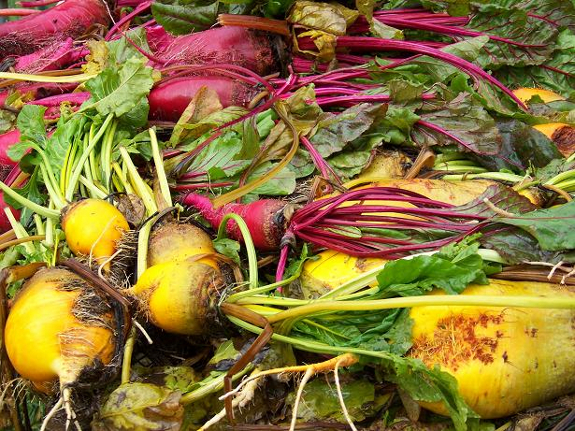
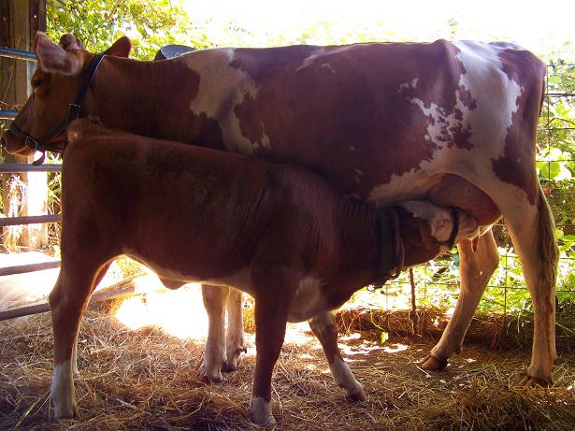
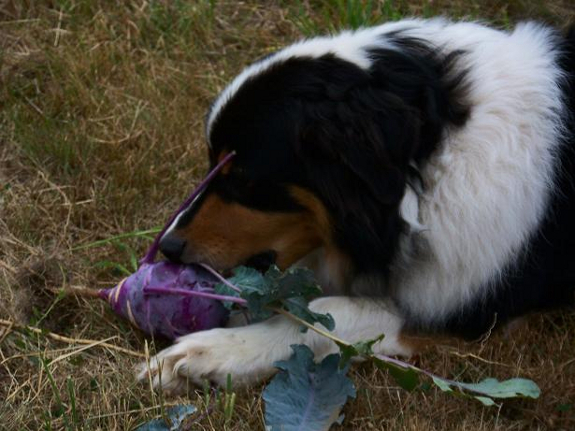
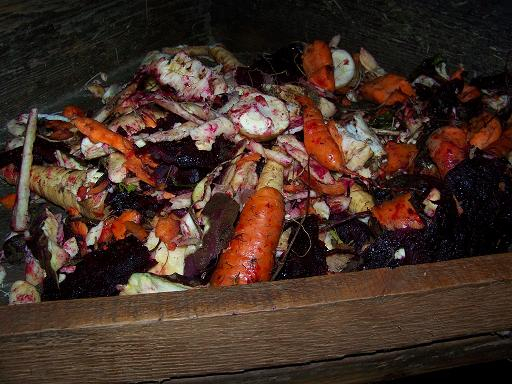
 Nita uses a
mechanical chopper to cut up the five pounds of mixed roots
she provides for her dairy cow each winter day. She
notes that the chopper processes the day's roots in one
minute, versus five minutes with a knife. Alternative
methods for processing roots for livestock include cooking
(essential when feeding potatoes to non-ruminants like pigs
and chickens), grating, or feeding whole and raw.
Nita uses a
mechanical chopper to cut up the five pounds of mixed roots
she provides for her dairy cow each winter day. She
notes that the chopper processes the day's roots in one
minute, versus five minutes with a knife. Alternative
methods for processing roots for livestock include cooking
(essential when feeding potatoes to non-ruminants like pigs
and chickens), grating, or feeding whole and raw."While the roots won't replace all the grain for your stock, they can play a bigger part of their winter diet, giving variety and giving you more control in what you are feeding your animals," Nita concluded. "Growing and harvesting roots has made us feel closer to our goal of self-reliance. And we find as we eat more of these types of in-season vegetables ourselves, we rely less on labor- and energy-intensive food-preservation methods. While I'm not giving up my canning and freezing, I find that I'm storing less food that way, and actually providing more variety in our meals."
$10 Root Cellar is free today on Amazon, so download your copy now! If you can't figure out the apps allowing you to read kindle ebooks on your computer or other device, you can also email me today for a free pdf copy. Thanks for reading!
| This
post is part of our $10
Root Cellar lunchtime series.
Read all of the entries: |
It takes us about 40 minutes
to clean out the sediment in our gray water tank.
Anna does most of the dirty
work because she's the most petite between us.
I think it's been 5 years
since we last did this chore. There might be some fertile elements in
that sediment, but we didn't think to save it till it was all splashed
out on the ground.
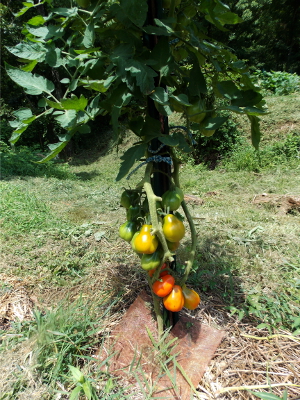 Even though I had steeled myself for the
tomato blight to hit early and hard in this wet summer, it still
hurt when the fungi took over our planting this week. We've
frozen a grand total of three pints of tomato-based soup so far,
and it's looking like this major component of our winter diet will
be scanty in 2013. (I still hope to put away a few gallons
of soup from the tomatoes ripening now, and the ones I'll end up
ripening inside once the blight beats my radical
pruning and
takes the vines, but it'll be much less than usual.)
Even though I had steeled myself for the
tomato blight to hit early and hard in this wet summer, it still
hurt when the fungi took over our planting this week. We've
frozen a grand total of three pints of tomato-based soup so far,
and it's looking like this major component of our winter diet will
be scanty in 2013. (I still hope to put away a few gallons
of soup from the tomatoes ripening now, and the ones I'll end up
ripening inside once the blight beats my radical
pruning and
takes the vines, but it'll be much less than usual.)
On the positive side,
we don't need nearly as much frozen food to take us through the
winter any more. Between our $10
root cellar, quick
hoops, and the discovery of brussels
sprouts, we fill at least half of our winter vegetable needs
with fresh, living food. Plus, gallons of fruit leather,
sauces, and jams should sweeten my winter disposition even without
the taste of summer tomatoes.
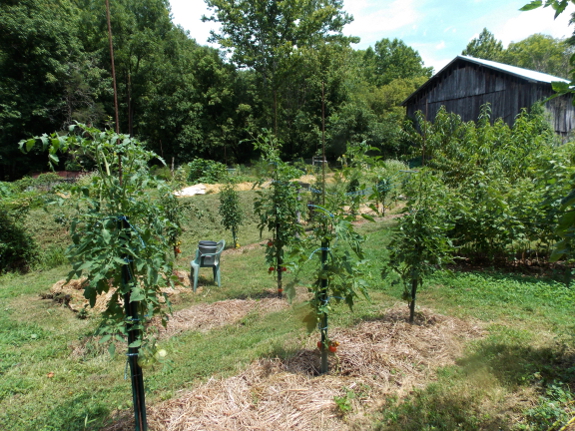
Still, it's worth
taking a minute to sum up factors I could change to slow the
spread of blight in later years. Even though weather is the
biggest reason our tomatoes are failing, I made a major blunder in
selecting their location this year, placing nearly half of our
plants in the gully. During a normal year, the gully would
have provided a sunny spot that was subirrigated,
allowing me to grow tomatoes without risking blight during
watering. But during a wet year, the gully turned out to be
a reservoir of infection. The first signs of blight showed
up there, and none of the plants in the gully did well. In
fact, our copper
experiment was
completely inconclusive because the primary factor that determined
blight damage this year has been proximity to those disease
carriers in the gully.
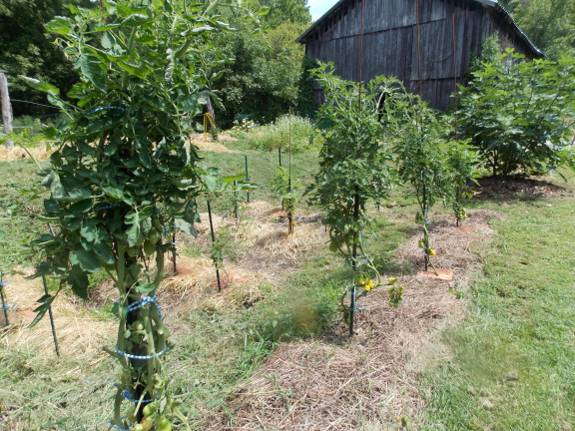
You can get an idea
for the difference between gully tomatoes and non-gully tomatoes
in the photo above. The plants in the background are in the
lowest part of the gully and have basically been pruned down to
nothing because of major blight damage. In contrast, the
foreground plants are much taller and have quite a few healthy
leaves left.
I could probably turn the gully into an okay tomato spot by
raising the beds up about two feet off the ground, but chances are
I'll just come up with another location for tomatoes in 2016,
after rotating our tomato plot through the back garden and the
forest garden.
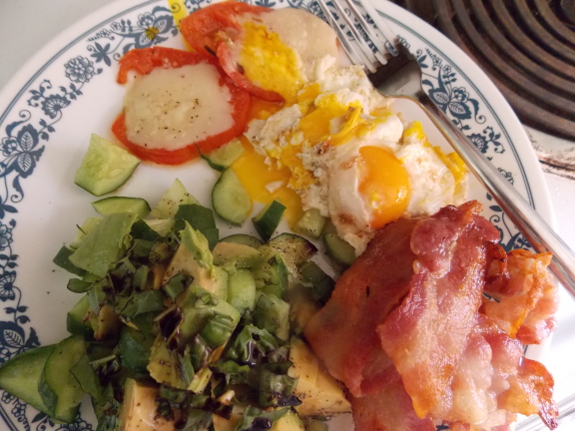
In the meantime, I'm
drowning my sorrows in other parts of the summer bounty.
Even a few tomatoes are delicious when fried and topped with swiss
cheese, parmesan, salt, and pepper. An influx of pullet eggs
and cucumbers reminds me that tomatoes aren't the be-all and
end-all of gardening life, even if they sometimes feel that way.
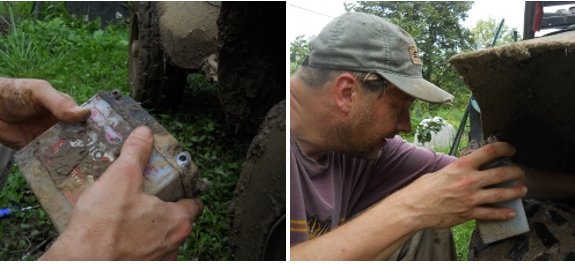
We've been having starting
issues with the ATV and I thought cleaning the muddy battery terminals
might fix the problem.
What I need to remember the
next time is to make sure not to lose the small nut that just sits on
the battery once you remove the screw that holds the wire to the
battery.
I heard it bounce off the
fender where it must have fallen into the grass, which means carrying
in the groceries the old fashioned way until I can find a replacement
nut.

This time of year
always feels melancholy to me, blight or no blight. We're
halfway through our frost-free period, and signs of autumn slowly
build. This year, the autumn feeling is coming faster, with
a low of 52 last week sending me hunting for a long-sleeved
shirt. Luckily, I have a sure cure for end-of-summer
melancholy --- pondering!
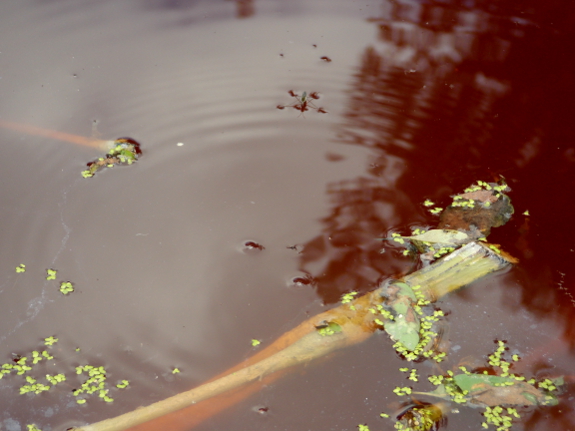
Even though I'm
supposed to be letting
the jewelweed ferment and gley my pond for at least two
weeks before adding anything that could boost oxygen content of
the water, I couldn't resist tossing in a gallon of pond inoculant
to get things moving. I aimed for transporting a few
clusters of parrots feather and some duckweed out of my tiny pond,
and ended up bringing along some water beetles and water striders
for the ride. Hopefully I got lots of even smaller critters,
too.
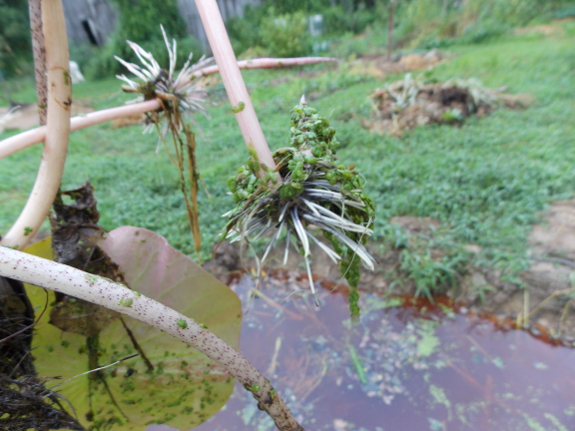
I couldn't resist
breaking off a runner from my lotus while I was at it. The
runner had multiple rooted points, and I pushed each into the mud
at the bottom of my sky pond with a long pole.
Something about these
various inoculants triggered the local dragonfly population, and
nearly immediately, half a dozen moved in. The most common
species (I'm thinking a Common Whitetail) was extremely
territorial, with up to five individuals chasing each other so
busily that no one got to spend much time at the pond. But
two smaller species slipped past the Whitetails' radar and hung
out on the lotus pads.

In the meantime, the
pond continues to be a bubbling cauldron of life, quite
literally. Pockets of gas continue to drift up from the fermenting
jewelweed, leaving an oily skim on the water surface. Now I
know why I sometimes see these oil-slicks in wild locations where
I can't imagine human impact has dropped anything in the water!
(And is it possible this oiliness is also why fermenting organic
matter seals a pond?)
Another odd
observation pertains to color. After the rain filled my sky
pond up, the contents suddenly turned reddish, and even though it
seems awfully coincidental that the roof feeding the pond is
glazed red, I can't imagine that so much pigment could be flaking
off a year after application. Ideas?
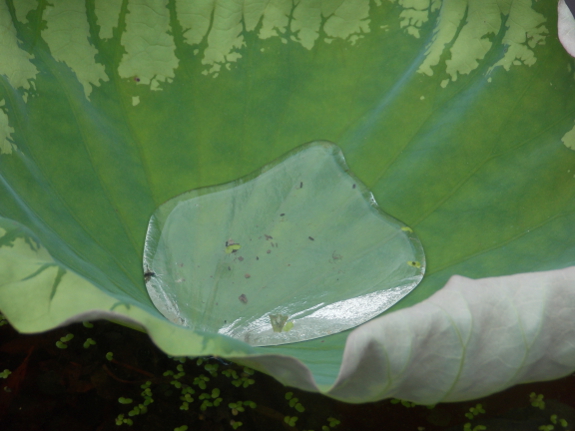
Of course, I know
you're probably far less interested in all of these natural
observations, and more interested in whether the sky pond is doing
its job. On Friday, as Kayla and I peered at my little pond,
she mentioned that she was able to walk across the ground above it
for the first time ever --- the swamp is drying up! I'd been
a bit afraid the soggy ground would just move to the downstream
end of the pond, but that doesn't seem to be the case either.
On the other hand, I suspect water levels in my little earth pond
are going to vacillate with the seasons. After I
measured the water depth at 13.25 inches Wednesday, we got
more rain in the afternoon that raised the pond water up another
couple of inches. And, since then, the pond level has been
slowly dropping, reaching 13.5 inches by Saturday morning.
I'll keep you posted on water levels (and far more than you
probably want to know about other aspects of the pond) as my
experiment progresses.
It turns out that those three
tip overs caused some wheel damage on the Bucket Hauler lawn trailer.
These wheels don't have
bearings, but some sort of holder broke away.
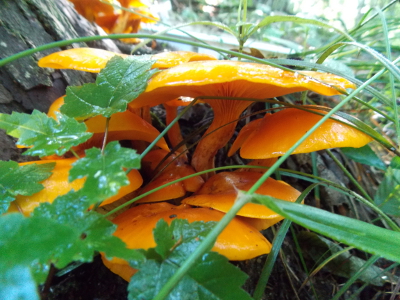 Two weeks ago, we got a
call from the sheriff's office. "There's an officer who
needs to see you. He's waiting at the mail box," the
dispatcher said.
Two weeks ago, we got a
call from the sheriff's office. "There's an officer who
needs to see you. He's waiting at the mail box," the
dispatcher said.
"Can you tell us what
it's about?" Mark asked, but the dispatcher had no answer.
So he rushed out on the ATV while I bit my figurative fingernails
and tried to decide if someone was dead or if I'd somehow broken a
law I didn't know about. It turned out, though, that I was
merely being summoned to jury duty.
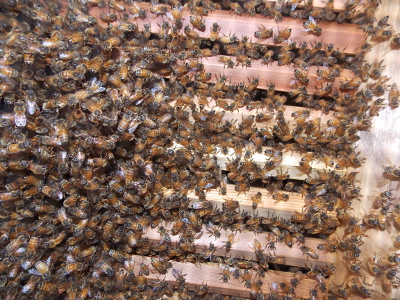 I should have guessed why the deputy
came calling. Our county court system had sent out a
questionnaire a few weeks earlier, asking if there was any reason
I wasn't eligible for jury duty. I probably could have
gotten out of it since one of the eligible excuses was being the
owner of a business with no employees (or something similar), but
I figured it was my civic duty to serve. Plus, I've never
been called for jury duty before and I always feel I owe it to
myself to try new things at least once, to expand my horizons.
I should have guessed why the deputy
came calling. Our county court system had sent out a
questionnaire a few weeks earlier, asking if there was any reason
I wasn't eligible for jury duty. I probably could have
gotten out of it since one of the eligible excuses was being the
owner of a business with no employees (or something similar), but
I figured it was my civic duty to serve. Plus, I've never
been called for jury duty before and I always feel I owe it to
myself to try new things at least once, to expand my horizons.
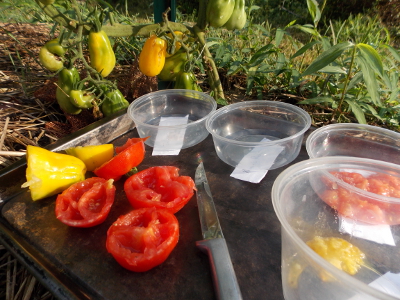 As the date got closer,
though, I started regretting my high-minded thoughts. Our
farm and business run like a well-oiled machine most of the time,
but that all breaks down if one of the two wheels is
missing. And the jury-duty literature refused to tell me how
long I'd be serving --- maybe just one day, but maybe up to the
entire four-month court session if there's some big trial I don't
know about.
As the date got closer,
though, I started regretting my high-minded thoughts. Our
farm and business run like a well-oiled machine most of the time,
but that all breaks down if one of the two wheels is
missing. And the jury-duty literature refused to tell me how
long I'd be serving --- maybe just one day, but maybe up to the
entire four-month court session if there's some big trial I don't
know about.
So I scurried around
to get the farm ready to live without me. Like most couples
who homestead together, Mark and I divide up our responsibilities,
and he can't really do my job any more than I can do his.
Things like checking the peach tree for brown
rot, saving
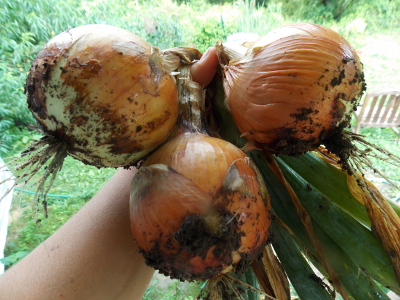 tomato
seeds, cooking up soup, and feeding the bees take longer to
explain than they do to perform, and I did my best to get caught
up for the next day or two on Sunday.
tomato
seeds, cooking up soup, and feeding the bees take longer to
explain than they do to perform, and I did my best to get caught
up for the next day or two on Sunday.
Which is all a long
way of explaining why, by the time you read this, I'll be winding
down a foggy, country road to the courthouse (and why your
comments won't come out of moderation until I get home). I felt
like a real weekend
homesteader trying to get ready for a 9 to 5 job that might
last all week, and I have to admit that I vastly prefer my
full-time homesteading status.
 As you can probably tell from all of my pond
experimentation last week, Tim Matson's Earth
Ponds did a
great job getting me excited about playing in the mud. I
read the second edition because a perusal of the table of contents
suggested it was pretty much identical to the newer edition, and
at the time Amazon had a used copy available for only $4.
(If you've looked at the third edition and see updates, I hope
you'll add your two cents' worth as comments on this week's
lunchtime series!)
As you can probably tell from all of my pond
experimentation last week, Tim Matson's Earth
Ponds did a
great job getting me excited about playing in the mud. I
read the second edition because a perusal of the table of contents
suggested it was pretty much identical to the newer edition, and
at the time Amazon had a used copy available for only $4.
(If you've looked at the third edition and see updates, I hope
you'll add your two cents' worth as comments on this week's
lunchtime series!)
The first third of
Matson's book is a chatty story of how he built his own pond
around 1980 in Vermont. He cleared trees in a wetland, then
hired a bulldozer to do the excavation. For $850, the
bulldozer operator dug out a large area (about 93 feet by 75 feet)
to a depth of 8  feet. Water seeped
in through the earth as the pond was was being excavated, then
overflow created its own spillway once rains arrived, with Matson
coming along behind to rock the water's path and prevent erosion.
feet. Water seeped
in through the earth as the pond was was being excavated, then
overflow created its own spillway once rains arrived, with Matson
coming along behind to rock the water's path and prevent erosion.
The rest of this
week's lunchtime series will hit the highlights of pond
construction according to Matson, but I wanted to provide a few
caveats up front. Earth Ponds is focused on creating
an earth-bottomed swimming hole that will keep fish happy and
provide a bit of water for the garden, so it won't be relevant to
everyone. If you want to make a little backyard pond like
ours, you'll have to guess and experiment, and if you want to
create a more vibrant ecosystem, you'll have to overlook all of
Matson's attempts to eradicate "weeds" (meaning any aquatic
vegetation) from his pond. Still, I've yet to find a better
book about earth-bottomed ponds, so Matson's text is at the top of
my list.
| This
post is part of our Earth
Ponds lunchtime series.
Read all of the entries: |
I was able to use a wheel
barrow wheel to get the Bucket Hauler going today.
The driveway still has deep
and uneven ruts, which has me re-thinking the trailer concept.
Maybe there's a way to carry
6 buckets on the ATV without the trailer trouble?
 "Ok, so an (Amazon Associate paid link to
a) graduate cylinder, and what I assume is fuel. But no details
on what test you're doing, how you're doing it, or how to
interpret the results. Let me rush right out to click your link,
buy the cylinder, and pour some gas into it. Not that I'd know
what the hell anything meant, but hey, you'd make a dime,
right?"
"Ok, so an (Amazon Associate paid link to
a) graduate cylinder, and what I assume is fuel. But no details
on what test you're doing, how you're doing it, or how to
interpret the results. Let me rush right out to click your link,
buy the cylinder, and pour some gas into it. Not that I'd know
what the hell anything meant, but hey, you'd make a dime,
right?"
While this comment is
a remarkably trollish response to a blog post meant to show you
tidbits of our personal life, I had been meaning to give our
readers more details on how simple it is to perform a test for
ethanol content of gasoline. All you need is something that
easily measures volume --- a 100 mL or larger graduated cylinder
takes nearly all the math out of your hands, but you could just as
easily use a ruler in a straight-sided glass cup or jar.
The idea is that when
you mix water with gas, any ethanol in the gas comes out of
solution and joins the water instead. So all you have to do
is know how much water you initially added to the gas, subtract
that out of the clear layer at the bottom of your graduated
cylinder at the end of the experiment, and the rest of the clear
substance is ethanol.
When starting your
ethanol test, the first step is to take your gas sample
carefully. As a
far-more-constructive commenter mentioned, you should run at least a gallon
of gas into your car before taking a sample from any pump that
uses a shared hose. Then pump a sample into a container and
bring the gas home to experiment.
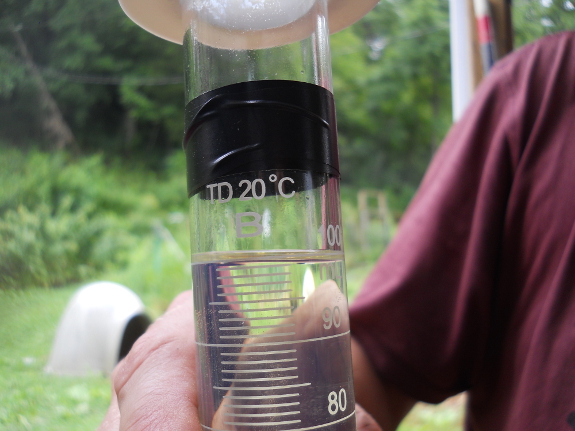
In the meantime, you
should take a minute to prep your graduated cylinder (assuming
you're like us and only bought a 100 mL one instead of a cylinder
with a larger capacity). Later in the experiment, you'll
need to know where the 110 mL line is, which is easy to guestimate
by measuring the distance between the 90 and 100 mL lines, then
measuring that same distance above the 100 mL line. To keep
things simple, use a piece of tape to wrap around the graduated
cylinder at the 110 mL line, marking its location.
Now you're ready to
add the gas. I found it much easier to pour some gas into a
small container rather than trying to fill the graduated cylinder
from the gas can. You want to add gas up to the 100 mL line,
and don't forget your chemistry lessons --- read from the bottom
of the meniscus!
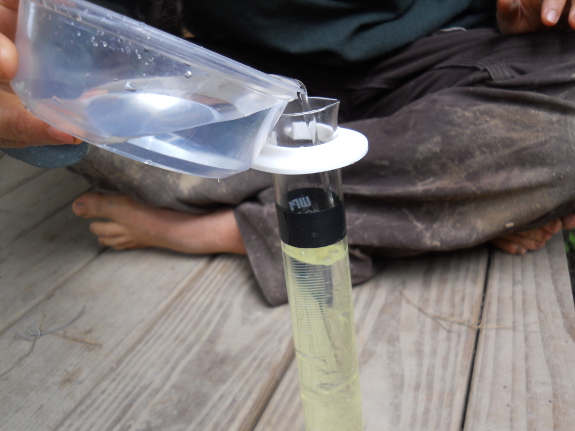
Top the gas off with
10 mL of water, meaning that the total liquid level should match
the taped 110 mL line. Then mix the contents.
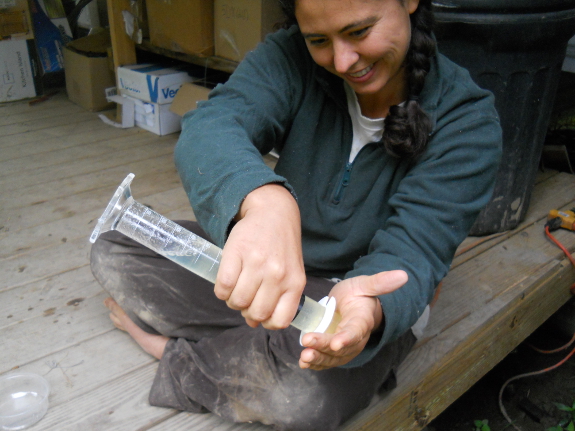
(Mixing was the
hardest part for me because our graduated cylinder didn't come
with a stopper, and I ended up slopping a bit of liquid out while
plugging the top with my palm. I think a better solution
would have been to use a sandwich baggie pulled over the top of
the graduated cylinder, or to invest in some parafilm.
Either way, thorough mixing is imperative.)
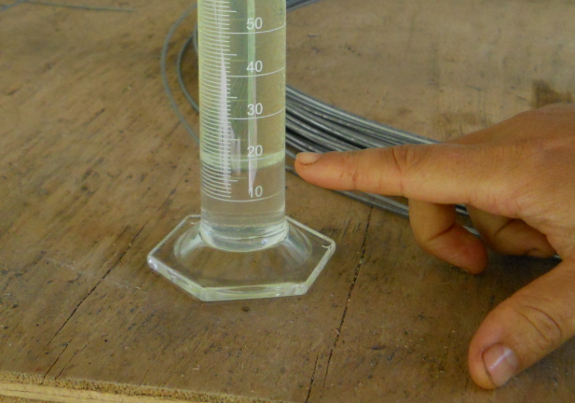
After mixing, the
clear ethanol and water will settle to the bottom, while the
colored gas will sit above it. You can easily measure how
much water and ethanol is present, then subtract 10 mL from that
to find the percent ethanol in the water. Probably because
of my sloppy mixing, our clear layer came to 17 mL, producing a
reading of 7% ethanol instead of the 10% listed on the pump at the
gas station. (If you didn't use the exact amounts of gas and
water I listed above, you'll have to do a bit more math: ((Clear
layer - Water)/(Gas))x100%.)
As Mark has mentioned
previously, ethanol
in gas can wreak havoc on many of the small engines found on our farm, so
it's useful to know for sure that the ethanol-free gas we've
hunted down really doesn't have any ethanol in it. We'll be
testing gas stations soon and hoping to find one near us that is
really ethanol-free.
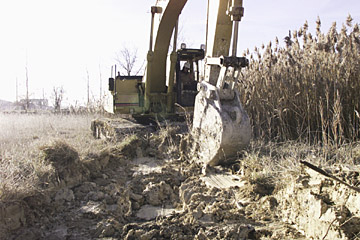 The most important
factors to consider when building a pond without a liner are
location and soil quality. You can get an idea for both by
digging test pits in an area where you want a large pond to
go. Each pit should be about eight to ten feet deep and
should be excavated during your driest season. You're
looking for rock ledges (bad), clay (good), and high groundwater
(good).
The most important
factors to consider when building a pond without a liner are
location and soil quality. You can get an idea for both by
digging test pits in an area where you want a large pond to
go. Each pit should be about eight to ten feet deep and
should be excavated during your driest season. You're
looking for rock ledges (bad), clay (good), and high groundwater
(good).
In different parts of
his book, Matson writes that pond
soil should be either 10% to 20% clay,
or at least 20% clay. As far as I can tell, more clay is
almost always better, unless you're building a dam (more on that
in a later post), in which case pure clay won't be as
stable. And, while we're talking about the earth, hitting
rock bottom in your test pit is a sign that you should put your
pond someplace else --- ledges, especially, allow water to flow
right out the bottom of your pond and disappear.
Equally as important
as the soil, you're looking for high groundwater in your test
pits. In a pond without a dam, the level of the groundwater
will tell you the eventual low-water level of your pond, so not
hitting water in your test pits is another sign you should look
for a different pond location. Of course, groundwater moves
slowly, and in
my experiment I
found that it took several hours for my excavation to fill up with
water, so give your test pits a day or two to fill before calling
them failures.
| This
post is part of our Earth
Ponds lunchtime series.
Read all of the entries: |
 Congratulations to Bernard, Letty, and Wendy,
who won our permaculture
onion giveaway!
Letty
regaled us with information about how she integrates chickens into
her Louisiana homestead, Bernard took advantage of old hay and horse manure on
his newly purchased farm to get the garden off to a good start,
and Wendy has created a bountiful, edible garden that fits into a
suburban front yard (pictured here).
Congratulations to Bernard, Letty, and Wendy,
who won our permaculture
onion giveaway!
Letty
regaled us with information about how she integrates chickens into
her Louisiana homestead, Bernard took advantage of old hay and horse manure on
his newly purchased farm to get the garden off to a good start,
and Wendy has created a bountiful, edible garden that fits into a
suburban front yard (pictured here).
Unfortunately, we
have more onions looking for homes than we had winners.
(Mark tells me the contest was too hard for most people.)
So, I'll make things easier for this second round and stick to the
old standby in the blogging world --- you plug one of our books or our chicken waterer in the social media
world, leave a comment on this post to let me know you entered,
and I'll draw names out of a hat on August 13 and give away Egyptian
onions until
we run out. Hopefully this will give folks a chance if they
missed our lightning giveaway or found the permaculture giveway
too hard. Thanks in advance for entering and spreading the
word about our products so we have time to share our adventures
with you on the blog!

I left you all
hanging about jury
duty because
they left me hanging too. Monday turns out to have been an
orientation day, after which I'm on call for half the work days
over the next three months. The system seems awkward --- I
have to check a website after 5:30 pm the night before each
potential trial date, and then I'll know whether the relevant
people decided to go to trial or not. According to the
judge, most cases end up being decided without a jury, and the
average juror is asked to serve only two days during that
three-month period.
So I'm back at work
on the farm, feeling unbelievably grateful to have such a
wonderful "work" environment! Chattering with Kayla as we
perk up the mule garden feels more like socializing than like
work, but we still get a lot done.
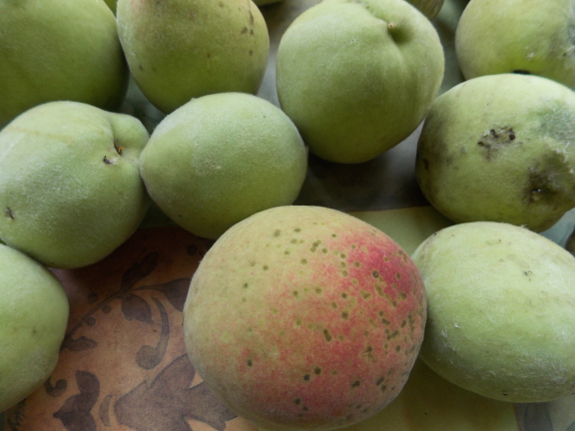
In case you wanted
something homestead-related in today's post, I've got two
disjointed observations to throw at you. The first has to do
with flowers --- have you ever noticed that the old-fashioned
annuals that are so easy to grow from seed (like the touch-me-nots
in the first photo in this post) attract the most
pollinators? The zinnias I half-heartedly tossed out into
the same flower bed are also drawing in butterflies and bees,
while the irises I was so happy about this spring were largely
ignored by insects.
My second observation
has to do with the peaches in the second photo. These are
the white peaches on our oldest tree, the first of which came down
with brown rot over the weekend. Even though the ground
color looks awfully green, I'm guessing this is the right
stage to pick them if I want to ripen white peaches inside.
Has anyone else had experience with the best time to pick white
peaches for indoors ripening?
 Tim Matson explains
that there are two types of earth
ponds --- the
dug-out pond and the embankment pond. The former is
generally built in a flat area where groundwater lies close to the
surface, while the latter works best in a valley that can be
turned into a pond by building a wall across the valley bottom.
Tim Matson explains
that there are two types of earth
ponds --- the
dug-out pond and the embankment pond. The former is
generally built in a flat area where groundwater lies close to the
surface, while the latter works best in a valley that can be
turned into a pond by building a wall across the valley bottom.
Dug-out ponds are
just what the name suggests --- a hole in the ground. They
can be quite small, and commercial fisheries often use a series of
dugout ponds in series rather than one big pond to make management
easier. In the case of the fisheries Matson mentioned in his
book, ponds are about 15 feet in diameter and 3 to 5 feet deep.
The main disadvantage
of a dug out pond is that the earth needs to go somewhere else ---
mounding it up around the sides just creates a really
funny-looking pond in a hole. If you live in a very wet
area, though, that excavated soil can be a pro rather than a con
--- Matson mentioned one farmer who dug out a pond in a very low
area, then used the soil to bring a nearly-as-low field out of the
marsh and into more productive conditions. We're
doing something similar on a much smaller scale with our pond
experiment.
The embankment method
is often used to create a larger pond since it's more
cost-effective to mound up the excavated earth as a dam, raising
the potential water level and increasing your volume twice as
quickly for each scoop of earth removed. However, embankment
ponds often blow out at the dam if you're not careful, so you'll
want to follow Matson's tips to clear the embankment area down to
the subsoil, then slowly build it up with impervious soil,
compacting after every foot or two. Unlike the walls of a
dugout pond, which can be as steep as 2:1, you should keep your
embankment flatter, with a maximum slope of 3:1.
 In both the case of a
dugout pond and an embankment pond, you need to think about how
water comes into and leaves the pond as well. Some dugout
ponds are sky ponds, relying completely on groundwater and rain to
stay full, but most ponds of both types are fed by a spring or
stream. Planning your inlet pipe so water cascades out onto
the pond surface will add oxygen, while burying the pipe keeps
water cooler in the summer and from freezing in the winter.
On the other hand,
you can use an unpiped inflow with a small settling pool just
before you reach the pond, preventing silt from entering the pond
proper.
In both the case of a
dugout pond and an embankment pond, you need to think about how
water comes into and leaves the pond as well. Some dugout
ponds are sky ponds, relying completely on groundwater and rain to
stay full, but most ponds of both types are fed by a spring or
stream. Planning your inlet pipe so water cascades out onto
the pond surface will add oxygen, while burying the pipe keeps
water cooler in the summer and from freezing in the winter.
On the other hand,
you can use an unpiped inflow with a small settling pool just
before you reach the pond, preventing silt from entering the pond
proper.
At the other end of
the pond, Matson is less keen on piping, having seen far too many
ponds leak around the outflow pipe. Instead, he recommends
creating a stone-lined spillway channel, or, if you absolutely
must pipe your outflow, adding an anti-seep collar around the
pipe.
Stay tuned for
tomorrow's post on sealing the earthen pond!
| This
post is part of our Earth
Ponds lunchtime series.
Read all of the entries: |
We tested out a new milk
crate ATV bucket holder system today.
Anna said "Do you think a
bucket would fit in one of those old milk crates?"
It was easy to attach the
milk crate to the ATV rack by weaving a few feet of rope through the
holes in the crate and pulling it tight against the rack.
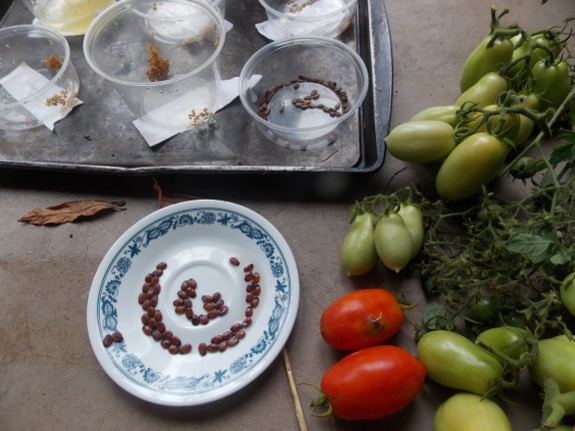
At this time of year,
the garden moves inside and spreads out across all flat
surfaces. Seeds
are fermenting or drying, to be eaten or planted. Tomatoes
from the vines I've deemed too 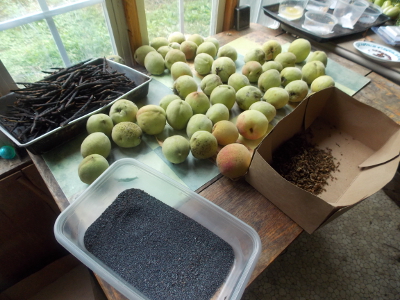 blighted are ripening on a table, and so are
the first few peaches from our late-fruiting tree.
blighted are ripening on a table, and so are
the first few peaches from our late-fruiting tree.
I can't quite
remember where I did all this work before we had a porch and moved
our summer dining outside. Actually, I've used up half of
the picnic table, too, for curing warty summer squash before we
smash them open and rip out the seeds.
What does your
seed-saving station look like?
 Earth ponds are never 100%
water-tight, but it's important to keep the seepage to a minimum
so water levels stay high. As I mentioned in a previous
post, compaction
and gleying are
two traditional methods of creating a (mostly) water-tight seal,
but you can't expect either one to be effective all at once.
A good pond will seep less and less over the course of the first
two years as sediment fills leaks and as the weight of the water
continues to compact the soil.
Earth ponds are never 100%
water-tight, but it's important to keep the seepage to a minimum
so water levels stay high. As I mentioned in a previous
post, compaction
and gleying are
two traditional methods of creating a (mostly) water-tight seal,
but you can't expect either one to be effective all at once.
A good pond will seep less and less over the course of the first
two years as sediment fills leaks and as the weight of the water
continues to compact the soil.
 But what if your
pond's still leaking in year three? Pond remediation often
includes adding native clay or bentonite (the latter of which is a
specific kind of clay) to the soil. To do so, you have to
drain any remaining water out of the pond, mix the additive into
the soil surface, then compact the pond to re-create the
seal. Bentonite generally comes as a powder, so you only
need one pound per square foot of surface, but with clay you'll
need to add a foot or two to create a good seal.
But what if your
pond's still leaking in year three? Pond remediation often
includes adding native clay or bentonite (the latter of which is a
specific kind of clay) to the soil. To do so, you have to
drain any remaining water out of the pond, mix the additive into
the soil surface, then compact the pond to re-create the
seal. Bentonite generally comes as a powder, so you only
need one pound per square foot of surface, but with clay you'll
need to add a foot or two to create a good seal.
If even this fails,
chances are you've picked
a poor site for your pond. In that case, it's best to find a better
location and try again.
| This
post is part of our Earth
Ponds lunchtime series.
Read all of the entries: |
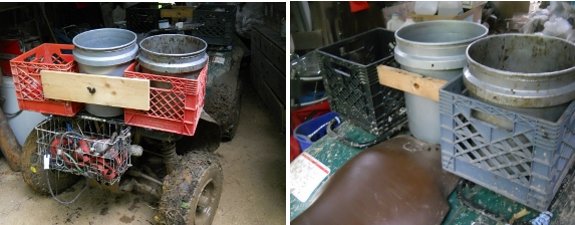
Anna's ATV
milk crate bucket holder
idea turns out to be a great solution!
We added two more crates to
bring the carrying capacity to six 5 gallon buckets.
It now takes 5 trips to empty
the truck compared to 3 with the trailer.

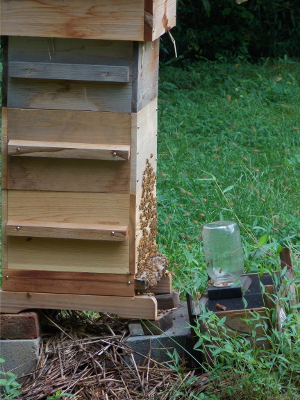 I've been giving sugar water to our two new
colonies every time the feeders empty, but at the beginning of
this week I decided they needed to start slowing down their
brood-raising for winter, so I let the feeders run dry. I
expected that would mean bee activity outside the hive would slow
down, but instead, I noticed bearding
again on our Warre package hive. I couldn't even get
the camera close without a bee suit, so I haven't looked inside
yet, but I'll probably add another box today just in case.
I've been giving sugar water to our two new
colonies every time the feeders empty, but at the beginning of
this week I decided they needed to start slowing down their
brood-raising for winter, so I let the feeders run dry. I
expected that would mean bee activity outside the hive would slow
down, but instead, I noticed bearding
again on our Warre package hive. I couldn't even get
the camera close without a bee suit, so I haven't looked inside
yet, but I'll probably add another box today just in case.
Seeing the bearding
on one hive prompted me to check on our other colonies, and all
were buzzing with life! My beekeeping mentor (aka my
movie-star neighbor) told me Wednesday that his hive was hopping,
which he attributed to the jewelweed flowers opening up.
Just within fifteen feet of one hive, though, I saw jewelweed,
woodland sunflower, and virgin's bower all coming into bloom, so I
suspect this nectar flow is due to a mixture of fall
flowers. Maybe the fall flow will be strong enough that
we'll get to harvest a bit of honey from our two-year-old hive
despite their
swarm this spring.
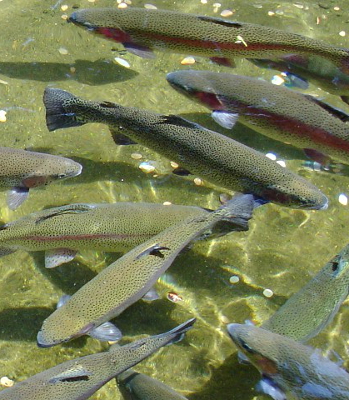 Tim Matson didn't
provide much information on pond biology because he was trying to
keep the plants in his pond to a minimum. However, he did
include a list of flora in his section on wildlife ponds,
mentioning that fish, ducks, and geese will all eat Sago pondweed,
wild celery, coontail, elodea, muskgrass (gives fish an off
flavor), arrowhead, wild Japanese millet, wild rice (needs flowing
water), lotus, waterlilies, iris, pickerel plant, burr reed,
cattails, smartweed, and bulrush.
Tim Matson didn't
provide much information on pond biology because he was trying to
keep the plants in his pond to a minimum. However, he did
include a list of flora in his section on wildlife ponds,
mentioning that fish, ducks, and geese will all eat Sago pondweed,
wild celery, coontail, elodea, muskgrass (gives fish an off
flavor), arrowhead, wild Japanese millet, wild rice (needs flowing
water), lotus, waterlilies, iris, pickerel plant, burr reed,
cattails, smartweed, and bulrush.
Fish were more
Matson's cup of tea, specifically trout. As with the paucity
of information on plant life, Matson didn't try to cover the needs
of different kinds of fish, but he did warn new pond owners away
from dropping fish into their water right away. It often
takes about a year for water quality to stabilize in an earthen
pond, with initially low pH and low-dissolved-oxygen levels slowly
being mitigated by an influx of organic matter and by the growth
of microorganisms. Short of buying water-testing equipment,
the best way to know if your pond is ready for fish is to drop a
few cheap ones in and see if they survive.
I hope you've enjoyed
these tidbits from Earth
Ponds, even
though the information is more suited to half-acre-and-larger
ponds than to little backyard water gardens. As you can
tell, I've been doing
experiments of my own about how to make an earth pond that
better fits the backyard, and I'll continue to keep you
posted about the results.
| This
post is part of our Earth
Ponds lunchtime series.
Read all of the entries: |
We filled the fourth Cadilac
worm bin with horse
manure today.
I think having full worm bins
is a bit of a warmer, fuzzier feeling than a full wood shed.
Firewood is something we
could buy if push came to shove, but a horse manure delivery service is
a homesteading fantasy from a hundred years ago.
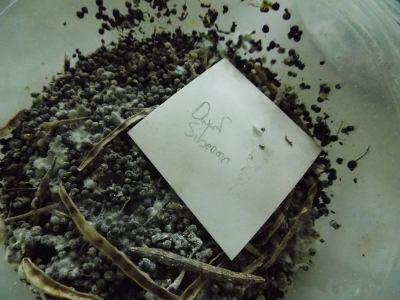 I had three surprises
Thursday --- one unpleasant, one pleasant, and one
interesting. Mark always takes his surprises from worst to
best, so I'll write this post that way too.
I had three surprises
Thursday --- one unpleasant, one pleasant, and one
interesting. Mark always takes his surprises from worst to
best, so I'll write this post that way too.
The unpleasant
surprise came when I pulled out the kale seeds I'd saved this
spring in preparation for planting our fall crop. The seeds
had rotted in the container! I'm usually pretty good about
harvesting seeds when they're as dry as possible, then letting
them sit out for another week or two in an open container to
finish dehydrating (especially if I'm going to seal them in
plastic instead of paper), but I clearly missed a step somewhere
along the way. Luckily, I have some 2012 seeds still kicking
around for one kale variety, and have time to order more of the
second variety since the whole month of August works for kale
planting around here. (I also snuck in a packet of Laciniato
kale into my seed order to try yet another variety.)
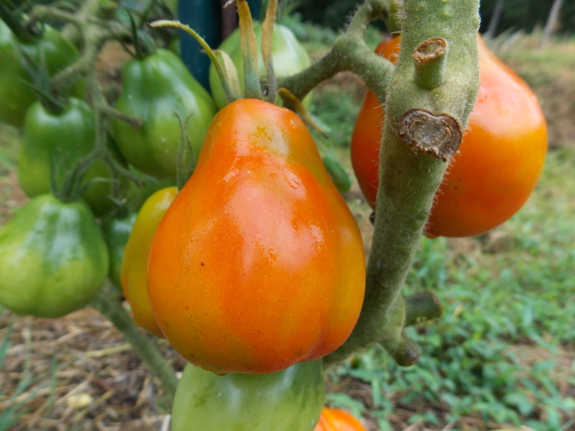
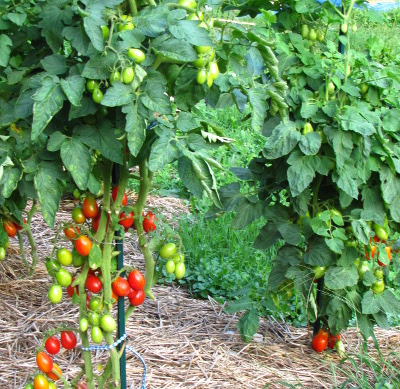 The interesting surprise came in the tomato
patch, where one of my yellow romas turned into an orangish roma
instead. Last year, a totally new tomato variety popped up
in my garden (shown to the right), and I assumed the seed had come
in with the manure. But now that I've seen this happen two
years in a row, I think I'm seeing the unusual-but-possible
effects of tomato hybridization. (Tomatoes are usually
self-pollinating, so you can grow several varieties in the same
patch even when saving seeds, but nature doesn't always play by
the rules.) I'm guessing this year's hybrid is probably a
Yellow Roma mixed with a Japanese
Black Trifele,
and I like the way I get the indeterminate, vigorous nature of the
Yellow Roma along with a heavier fruit set and a reddish
fruit. Last year's little red roma bred true, so I'll save
some seeds of the new hybrid too and will start pondering names
for my newly created tomato varieties.
The interesting surprise came in the tomato
patch, where one of my yellow romas turned into an orangish roma
instead. Last year, a totally new tomato variety popped up
in my garden (shown to the right), and I assumed the seed had come
in with the manure. But now that I've seen this happen two
years in a row, I think I'm seeing the unusual-but-possible
effects of tomato hybridization. (Tomatoes are usually
self-pollinating, so you can grow several varieties in the same
patch even when saving seeds, but nature doesn't always play by
the rules.) I'm guessing this year's hybrid is probably a
Yellow Roma mixed with a Japanese
Black Trifele,
and I like the way I get the indeterminate, vigorous nature of the
Yellow Roma along with a heavier fruit set and a reddish
fruit. Last year's little red roma bred true, so I'll save
some seeds of the new hybrid too and will start pondering names
for my newly created tomato varieties.
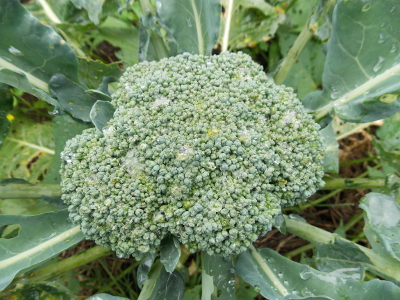 The final surprise was a
spring broccoli plant that produced a delicious head in
August! Usually, I rip out any spring broccoli that doesn't
mature in a timely manner since summer's heat prompts the plants
to produce measly heads that aren't worth the garden space.
But this broccoli was tucked away in the forest garden, so I
forgot about it. And the cool wet summer resulted in
beautiful head after all! I guess I should have been more
serious about planting broccoli during this wet summer to take the
place of our ailing tomatoes. I did have an extra dozen
brussels sprouts sets, though, which are now getting their feet
under them between the soon-to-be-gone tomatoes:
The final surprise was a
spring broccoli plant that produced a delicious head in
August! Usually, I rip out any spring broccoli that doesn't
mature in a timely manner since summer's heat prompts the plants
to produce measly heads that aren't worth the garden space.
But this broccoli was tucked away in the forest garden, so I
forgot about it. And the cool wet summer resulted in
beautiful head after all! I guess I should have been more
serious about planting broccoli during this wet summer to take the
place of our ailing tomatoes. I did have an extra dozen
brussels sprouts sets, though, which are now getting their feet
under them between the soon-to-be-gone tomatoes:

Any surprises lately
in your garden?
Before I became a homesteader
I would usually observe the end of Summer being when young people would
go back to school....often thinking "better you
than me!" with great
relief that I have already completed my State
required dose of compulsory education.
These days Anna and I have
our very own end of Summer ritual....the hatching of the year's last
batch of incubated
chicks.
They started showing up
yesterday...and now we have an excited baker's dozen.
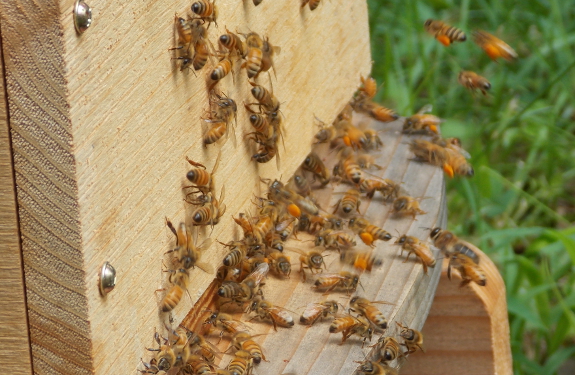
I slipped out just
before dark to take a photograph under our three-box Warre hive to
see if bearding really meant they were
running out of room inside. It's a good thing the bees were
slowing down for the night, because even the underside of the
screened bottom was coated with bees! The out-of-focus photo
below is the best shot I could get inside, but it's pretty easy to
see that the bees needed more room.
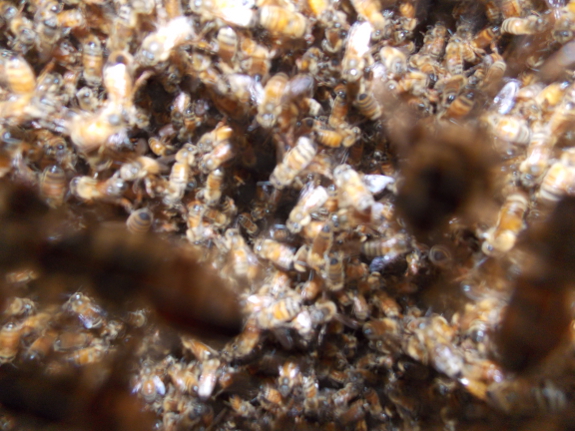
Unfortunately, the
next day it rained. A two-hour break in showers was enough
to get the bees out and moving, so I figured I'd be able to nadir
the hive, even though I knew they'd be unruly. I suited up
very carefully because overcast days are the worst time to open up
a hive, and
the bees were definitely displeased with my actions. Good
thing I've got a few years of beekeeping under my belt now and
know to just take a step back, take a few deep breaths, and let
those angry ladies batter themselves vainly against my veil.
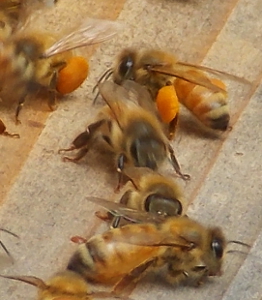 I didn't want to bother the colony longer
than necessary since the bees were so upset, so I just plopped the
fourth box underneath and went to peer at the entrance.
Warre hives have smaller openings than Langstroth hives do, and
this is one day the bees could probably have used more room.
There was a traffic jam of bees coming and going, but I was able
to see a lot of brilliant yellow-orange pollen on several of the
incoming bees. Sounds like the colony is still beefing
itself up by raising more brood --- here's hoping they don't eat
through their winter stores too quickly with so many new mouths to
feed.
I didn't want to bother the colony longer
than necessary since the bees were so upset, so I just plopped the
fourth box underneath and went to peer at the entrance.
Warre hives have smaller openings than Langstroth hives do, and
this is one day the bees could probably have used more room.
There was a traffic jam of bees coming and going, but I was able
to see a lot of brilliant yellow-orange pollen on several of the
incoming bees. Sounds like the colony is still beefing
itself up by raising more brood --- here's hoping they don't eat
through their winter stores too quickly with so many new mouths to
feed.
I haven't written much about my other two hives in a while, but
that's because they aren't as busy. The workers are all out
harvesting the current nectar-and-pollen source, but I don't see
any signs that either hive might be running out of room. If
anything, I might end up taking the fourth box out from under our
two-year-old hive and giving it to our package hive if both
colonies keep acting the same way in the near future --- the
package hive has been filling boxes like crazy, while the
two-year-old hive seems quite content to use two-and-a-bit boxes
for the foreseeable future.
Once upon a time Anna and I
tried selling Cattails on E-Bay to pay some bills.
Now we just admire their
beauty and water absorbing power near our wetland
pond.
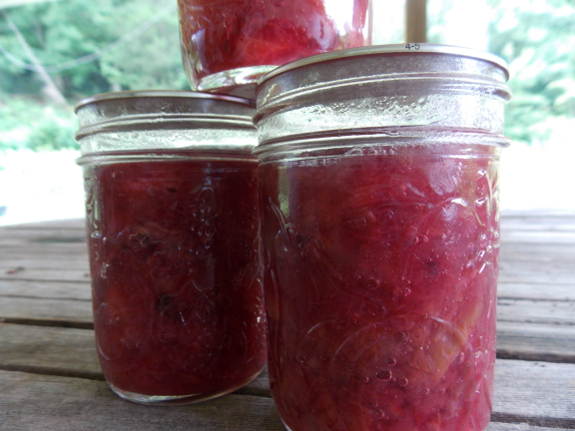
For the first time
this year, I'm realizing that it's possible to reach the point
where I've made enough fruit
leather and freezer
jam, have gorged myself on fresh, and still have an excess
of summer fruits. I plan to can whole peaches once the
fruits from our late tree are entirely ripe, but the
half-ripe-but-brown-rot-affected peaches also need a home, and
those seemed like a good candidate for jam.
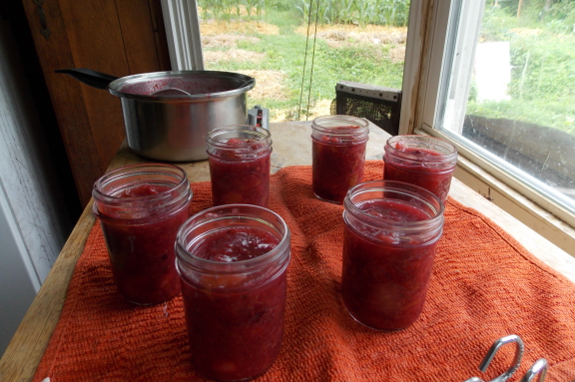
We don't eat much
jam, partly because we've eliminated bread from our diet, but more
because jam is just so sweet that it seems like a dessert, even
when mixed with yogurt. Despite the name, the "low-sugar",
cooked jam recipes inside the SureJell box call for 3 cups of
sugar for every 4.5 cups of peaches, and I wanted to go much lower
than that. So I started reading up on long-boil jams, where
the combination of evaporating off water and candying the sugar
produces a gel without the sugar-pectin reaction.
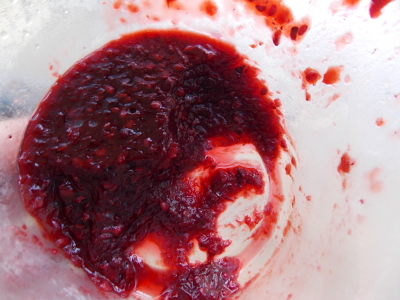 For my first experiment, I
used 1 cup of sugar, a box of low-sugar pectin, 1.5 cups of
peaches, and 3 cups of blackberries. The result was a very
well-set jam (although far too seedy). I didn't have any
canning lids on hand, though, so I just stuffed this first
experiment in the freezer.
For my first experiment, I
used 1 cup of sugar, a box of low-sugar pectin, 1.5 cups of
peaches, and 3 cups of blackberries. The result was a very
well-set jam (although far too seedy). I didn't have any
canning lids on hand, though, so I just stuffed this first
experiment in the freezer.
After sending Mark to
town for canning lids and accumulating another four or five cups
or so of problematic, unripe peaches, I decided to try again, this
time without pectin. I cut up the peaches into big chunks
(instead of sending them through the food processor the way I did
last time), added about half a cup of blackberries and 1 cup of
sugar, and tossed in half a cup of the seedy blackberry jam from
round 1. (So I guess this experiment did involve a little
bit of store-bought pectin.)
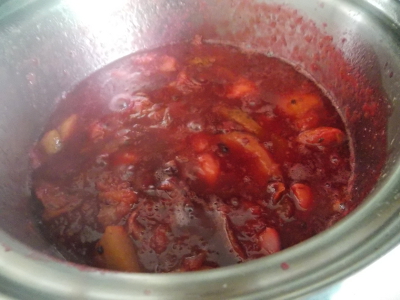 As the jam was cooking, I
started looking up instructions for canning jam. The
SureJell recipes simply call for sterilizing the jars, pouring the
hot jam in, then putting on the lids, with no further
processing. While that might have been acceptable even
without the pectin, I wasn't sure enough to give it a try.
As the jam was cooking, I
started looking up instructions for canning jam. The
SureJell recipes simply call for sterilizing the jars, pouring the
hot jam in, then putting on the lids, with no further
processing. While that might have been acceptable even
without the pectin, I wasn't sure enough to give it a try.
Meanwhile, extension service websites tell me that sugar isn't
necessary for preventing spoilage --- that its purpose in jam is
merely to maintain the color and to produce the gelatinous
consistency. But they also recommend processing any jam for
5 minutes in a hot water bath if you live below 1,000 feet in
elevation, and for 10 minutes if you live between 1,000 and 6,000
feet.
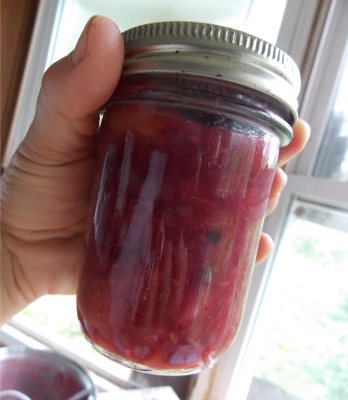 Despite this data, I was
still stumped because the aforementioned extension service
websites assumed I'd be adding pectin of some sort, not using the
older, boil-down method of jamming. To be entirely safe, I
figured I could use the processing guidelines for canning plain
fruit, but I couldn't find any data on how many minutes to process
peaches and blackberries in cup-size jars. I did, however,
read that prolonged boiling weakens pectin, so I opted to stick to
the extension service's 10-minute guidelines after all.
Despite this data, I was
still stumped because the aforementioned extension service
websites assumed I'd be adding pectin of some sort, not using the
older, boil-down method of jamming. To be entirely safe, I
figured I could use the processing guidelines for canning plain
fruit, but I couldn't find any data on how many minutes to process
peaches and blackberries in cup-size jars. I did, however,
read that prolonged boiling weakens pectin, so I opted to stick to
the extension service's 10-minute guidelines after all.
The result is six
little jars of light-maroon jam, which seems to have set up pretty
well as it cooled. I guess I won't know for sure if my
experiment was a success until I wait a few weeks and open up a
jar to see what's going on inside.
I'm very new to
recipe-less jam-making, so I'd love to hear about your
experiences. Any other favorite ways to process small
amounts of excess fruit, or (looking ahead), lots and lots of
peaches?
We retired some chickens
today, and for years we've been using this black bucket as an easy, DIY
substitute to the traditional Kill
Cone that has worked for thousands of backyard chicken people. My
Mom made the hole so she could grow an upside down tomato plant back
when that was all the rage in modern gardening techniques. She went
back to putting her tomatoes in the ground and offered us the bucket one
day.
That bucket collected dust in
the barn for a year or two until we started processing our own poultry.
We mounted a shelf bracket so it could hang at an easy height and it
worked well at keeping the bird still while its head poked out through
the hole.
Trial and error showed us the
hole was too big. The more aggressive chickens could sometimes get one
of their claws through the hole, complicating the procedure.
Today I finally modified an
old bucket with a smaller hole which seems to be a huge improvement. A
2 inch hole saw makes the opening just big enough for a chicken's head
without the extra room version 1.0 offered.
 Mark and I were recently
included in A
Way of Life Less Common, by Christine Dixon. The book consists of
interviews of six couples and one mother who are homesteading,
living off the grid, and/or running a home-based business. I
particularly enjoyed hearing from several homesteaders in Canada,
where the terminology is a bit different, but the ideas are very
similar to those Mark and I base our lives on.
Mark and I were recently
included in A
Way of Life Less Common, by Christine Dixon. The book consists of
interviews of six couples and one mother who are homesteading,
living off the grid, and/or running a home-based business. I
particularly enjoyed hearing from several homesteaders in Canada,
where the terminology is a bit different, but the ideas are very
similar to those Mark and I base our lives on.
A Way of Life Less Common
is a bit like the profiles in Trailersteading
--- an interesting overview of why people chose similar lifestyles
for different reasons. One homesteader was drawn to
alternative building practices, another to wilderness ("bush")
skills, and yet another to providing a better environment for her
young son. You'll see tidbits of their daily lives (I
thought we had invented the concept of going-to-town clothes vs.
work clothes!), and will read about their biggest trials and
successes.
Mostly, though, I
enjoyed rereading my own chapter because I'd forgotten how Mark
interspersed his observations with mine. Like a love letter
I had forgotten existed! If you want to learn about our
early years on the farm (and about other homesteading bloggers),
you can get $2 off the cover price by going to Createspace and entering this code:
D9CP2GX3. Enjoy!
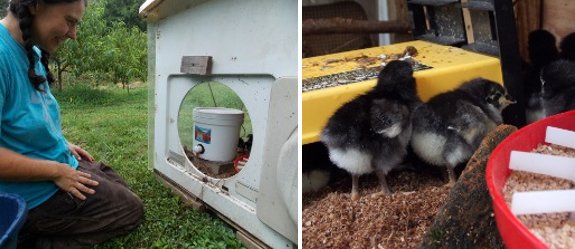
Today the new
chicks moved out of the
plastic tub and into their outdoor
brooder.
They seem to like scratching
around in a few inches of sawdust.
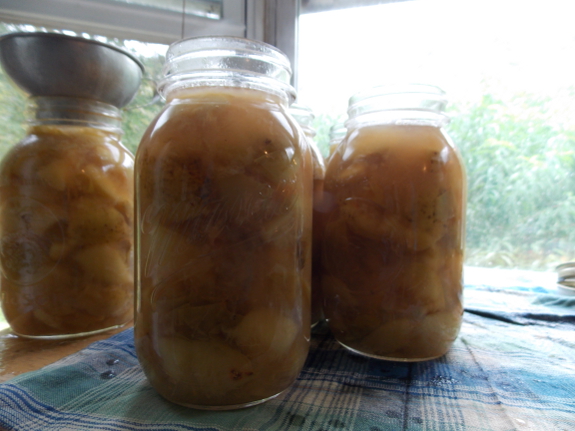
When it comes to
fruit management, Mom talks about separating the sheep from the
goats. The sheep are the good fruit that will last for a
while as-is, while the goats are damaged and need to be processed
ASAP.
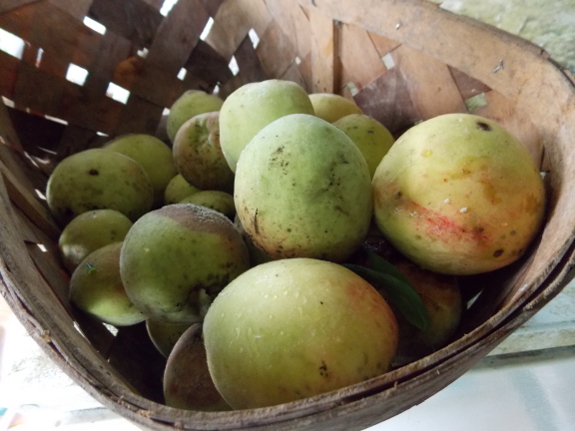
I accidentally
started sorting the sheep from the goats on our kitchen peach last
week when I
picked the more-damaged-looking peaches to bring inside and ripen. In retrospect,
those peaches were a little too unripe to reach perfection off the
tree, but I suspect my premature picking was instrumental in
keeping brown rot to a minimum on the tree despite nearly constant
rain. Brown rot first hits fruits with insect wounds or that
are touching other fruits, so removing those peaches before the
sugar content was high enough to feed the rot lowered the overall
fungal pressure for the tree. (I've been picking fallen or
rotten fruits at least every other day since then, too, which also
helps, but there have been many fewer rotten peaches than I
expected given this year's weather.)
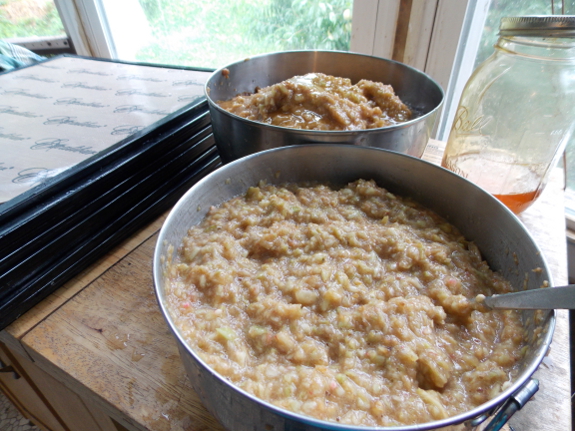
What all of this
sorting means in the real world is that I had at least half a
bushel of "goats" looking for a home Tuesday. Our freezer is
getting pretty full of fruit leather, but Mark talked me into
filling up the dehydrator one more time, then I opted to can the
rest of this batch of peaches. My goal is to have lots of
different variations
on preserved peaches to pick between this winter, allowing us to select our
favorite methods to focus on in later years.
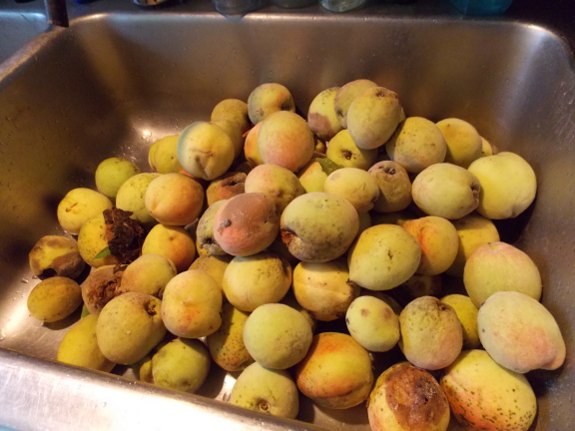
My go-to source for
basic canning information at the moment is the National
Center for Home Food Preservation, but that website nearly steered me wrong
this time. If other sources on the internet are to be
believed, white peaches are like tomatoes --- only borderline
acidic enough for hot-water-bath canning. So even though the
NCHFP website didn't mention this, I added a tablespoonful of
lemon juice per quart to ensure my peaches are acidic enough to
can outside a pressure canner. Since I was adding lemon
juice, I decided to take NCHFP's advice on a different matter and
can in a very light syrup of 1-1/4 cups sugar in 10-1/2 cups
water, even though I'd been planning to can unsweetened peaches.
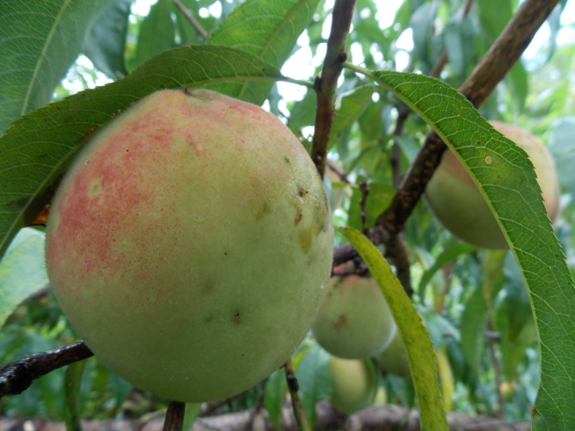
The rest of the
peaches on our kitchen tree look like sheep, although I'm sure a
few more will develop rot spots and bird bites in the next week or
so as they ripen. I plan to experiment next with making
peach sauce, then with a jam involving pectin, and then Mark will
probably talk me into turning the rest of the harvest into fruit
leather. That's not counting all the peaches I'll dice up
and add to our raspberry-and-blueberry-with-whipped-cream
desserts, of course.
Wild brambles eat through the Stihl FS-90R trimmer line pretty fast, but it's worth it for the extra garden space we've reclaimed this year.
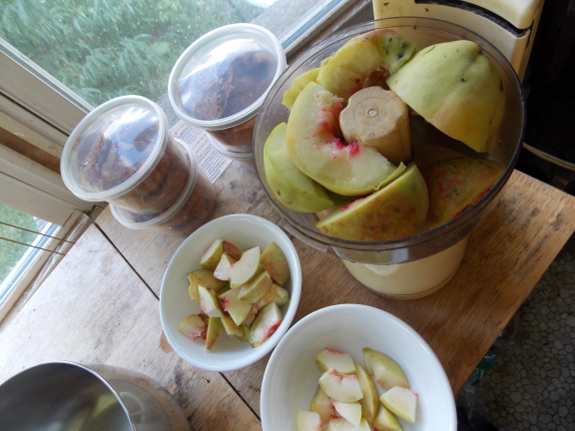
Another rainy night,
another third of a bushel of white
peaches on the ground in the morning waiting to be
processed. I didn't feel like spending two mornings in a row
slaving over a hot stove, so I turned this batch into fruit
leather, but tomorrow's peaches are earmarked for jam. Kayla
is bringing me some green apples from her grandmother's trees
today and I'm sending her home with some of our peaches, so we'll
both be able to experiment with making jam using homemade apple
pectin.
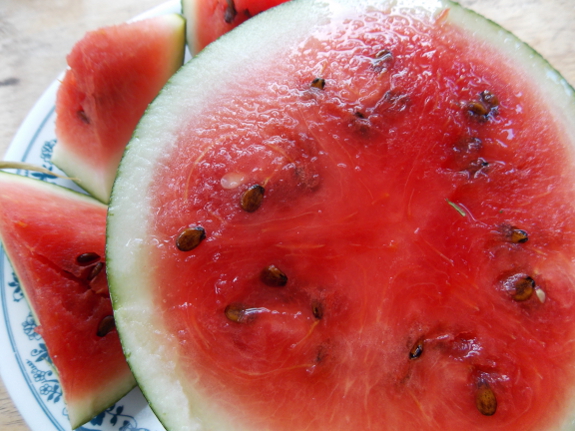
Even though the
peaches are right outside the kitchen window and are thus on the
top of my mind, other fruit is still pouring in. This has
turned out to be our best watermelon year ever, even though two
of our three beds failed. I suspect the amazing flavor
from the remaining bed is due to constant subirrigation from roof
overflow. Perhaps those
new garden beds in the gully that were too wet for tomatoes
could be built up just a bit and then would become the best
possible spot for water-loving watermelon next year?
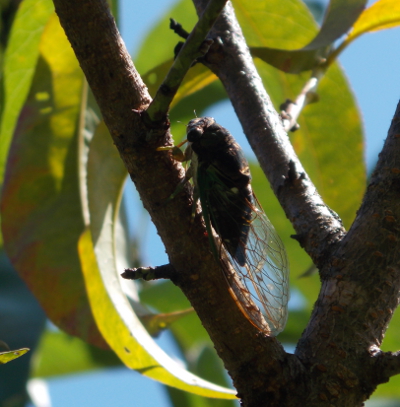 Daddy saved all of his
Egyptian onion top bulbs, and he tells me he has enough to allow
everyone who entered our
most recent giveaway to be a winner!
Daddy saved all of his
Egyptian onion top bulbs, and he tells me he has enough to allow
everyone who entered our
most recent giveaway to be a winner!
So, Adriana, Charles, Heather, Elizabeth, Jackie, Christine, jen,
WendP, and Nena, please email your mailing address to anna@kitenet.net and Daddy will get your
onions to you as soon as they dry out enough to go in the box
(probably next week).
Thank you all for entering!
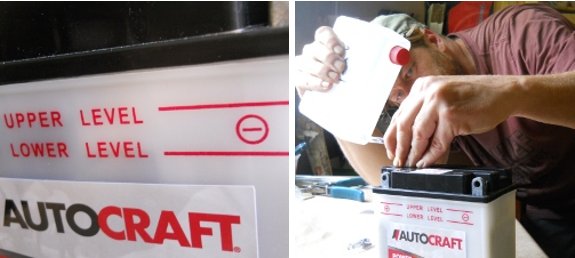
We've been having starting
problems with the
ATV.
It was cool enough for long
sleeves this morning and the old battery groaned without cranking. What
is it about a marginal battery and the first cold spell of the season?
Filling a new battery with
fresh sulphuric acid was easy and only took a few minutes. We'll use a
trickle charger to power it up and hopefully have it ready to go for
tomorrow morning straw
hauling.
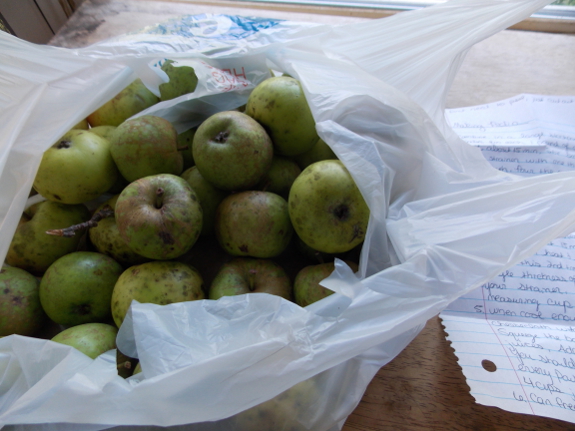
Kayla
not only brought me a big bag of green apples, she also copied
instructions out of a book (The Big Book of Preserving the Harvest) for turning those apples into
pectin. I mostly followed that recipe, which amounts to
extracting the juices from the apples in two parts. Here's
how....
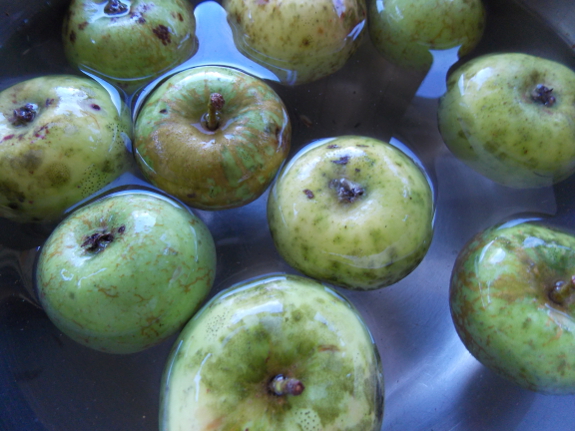
First, I rinsed the
apples and quartered them, removing any really rotten spots, but
leaving cores, skins, and small dark spots in. I covered the
apples with water, brought them to a boil, then simmered for 15
minutes.
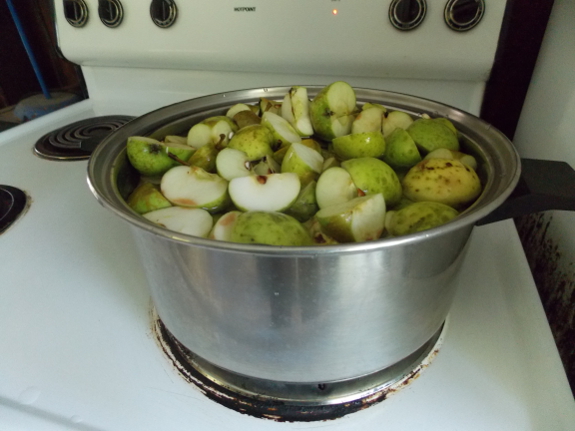
The next step is to
strain the apple pulp through cheese cloth, but I didn't have any
on hand. Luckily, the internet had a solution --- use an old
t-shirt instead. I had to double up the t-shirt so that
apple bits wouldn't squirt through the large holes that had
relegated the shirt to 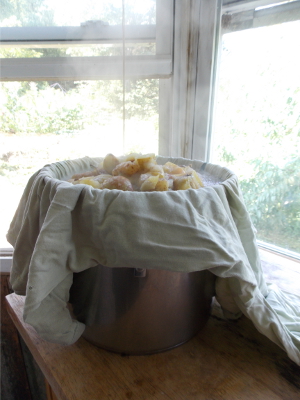 the rag-bag, but the double thickness didn't
seem to be a problem. I put the shirt on top of a steamer,
the steamer on top of the pot that fits beneath it, and the apple
pulp in the shirt, then waited about ten minutes for the juices to
ooze out.
the rag-bag, but the double thickness didn't
seem to be a problem. I put the shirt on top of a steamer,
the steamer on top of the pot that fits beneath it, and the apple
pulp in the shirt, then waited about ten minutes for the juices to
ooze out.
Next, the author
recommends putting the apple pulp back in the pot, covering it
with water again, and simmering for another 15 minutes to get yet
more pectin out. At the end of that period, you're supposed
to remove the apple mixture from the heat and let it stand for ten
minutes before straining again. Since this second time
around is the last strain, you'll want to squeeze everything you
can out of the apple pulp, which means waiting until the contents
are cool enough not to burn your hands.
The author says
you'll harvest a quart of juice for each pound of apples you
started with, but I used less water for the second round of
boiling (just covering the pulp) and instead ended up with closer
to a pint of juice per pound of apple. A quart of the less
concentrated apple stock is supposed to be equivalent to half a
bottle (3 ounces) of store-bought liquid pectin.
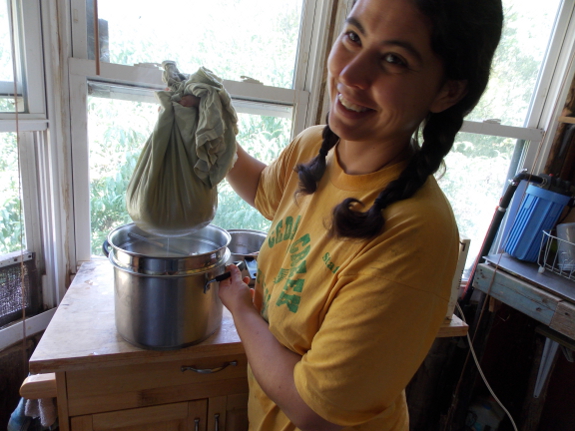
I'll tell you more
about my first attempt to jam with this homemade pectin later, but
I wanted to close by mentioning other recipes I've seen for
extracting pectin from apples. One recipe recommends cooking
your apples for several hours, which would presumably concentrate
the pectin (although I thought I'd read that extended cooking
damages pectin). Another recipe simply calls for adding
apples with the other fruit while making jam instead of extracting
the pectin first --- in this case, it's recommended to put the
skins and pits in a cheesecloth bag to simmer with the jam then be
removed at the end, while the apple pulp is included with the
other fruit.
I'd be curious to
hear from anyone else who's experimented with using green apples
(or other non-store-bought components) to make your own
pectin. Please comment and share your experiences!
Putting a new
battery in the ATV didn't
help.
I was able to use the pull
cord to get it started and up on the trailer for a trip to the ATV
repair shop in St Paul.
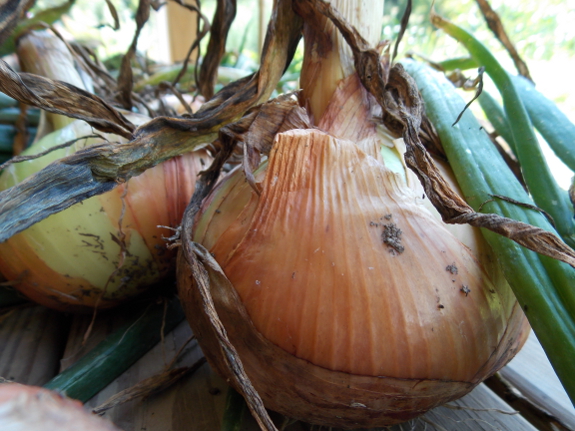
Our storage onions
began their lives as seedlings in the middle of February, hit the garden
in April, and
were finally harvested this week. I actually would have
liked to leave them in the ground a bit longer until the tops
completely died back, but it's so wet some of the bulbs were
starting to rot. (You know the weather is damp when you hang
your laundry on the line Monday, take it in halfway-dry to drape
inside when it starts to rain that afternoon, and then find mold
growing on your still-damp clothes Wednesday morning.)
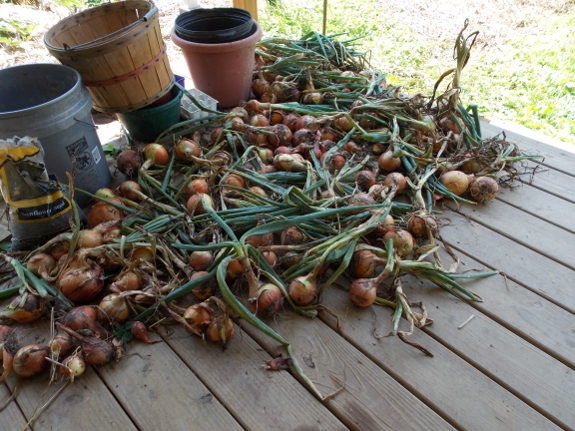
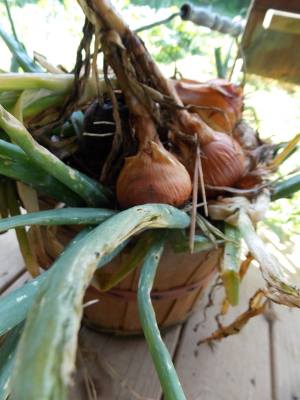 A bit of rot aside, the
onions look great this year, although I suspect there won't be
enough of them (again). I've actually been harvesting onions
out of the garden for the last month to cook with, so I guess the
harvest was really bigger than it seems from this photo.
A bit of rot aside, the
onions look great this year, although I suspect there won't be
enough of them (again). I've actually been harvesting onions
out of the garden for the last month to cook with, so I guess the
harvest was really bigger than it seems from this photo.
I spread our haul out
to dry on the front porch instead of on the drying
racks partly
from laziness, but also because I want to be able to pick through
the onions as they dry and use up problematic bulbs
immediately. Mark's mom has given us a screen rack I'm
looking forward to trying out with the onions...once the ATV is
back in working order and we can haul it in.

The light gates I've made for
our chicken
pastures tend to sag a
little over time.
It took over 8 gates to
figure out that the turn and block method with a scrap piece of wood is
a better match than the fancy looking hook and eye latch.
The hook and eye gate latch
is out of adjustment with just a small amount of sag, but the turn and
block method still works no matter how much the gate has shifted.

One of our Egyptian
onion winners
included a note asking for an update on our composting
toilet.
I'd actually been meaning to write a post on the topic, but it's
really more of a Mark post than an Anna post --- there's not much
to say when things just work. But Mark is still not entirely
excited by the idea of humanure (although he does agree our new
system is better than our old one), so hopefully you will all
forgive a bit of a light post from me on the weekend.
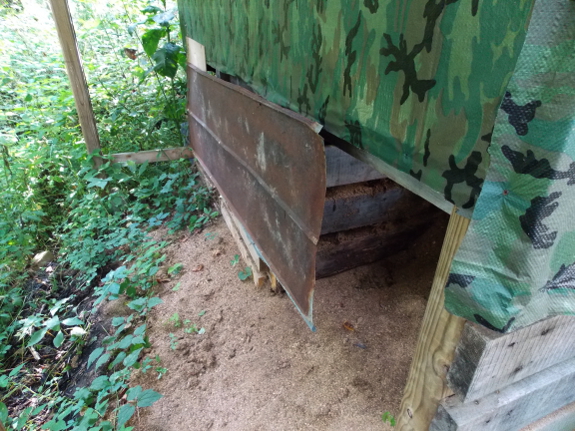
Keeping
wildlife out of the excrement has been the only real problem with our composting
toilet. After Mark added tin to the sides last winter, we
didn't see another problem until last week when something reached
through one of the few cracks still exposed. We'll cover
that opening up soon, and will definitely cover all the gaps
before moving to the next hole this fall. I had originally
thought the compost chamber needed those openings for aeration,
but there seems to be plenty of air flow through the open seat and
smaller cracks without leaving big gaps between the wooden walls
(as was proven by the sniff
test). I've seen a few flies hanging around, but not
even as many as are in the chicken pastures, so I figure our
sawdust covering is doing its job well there.
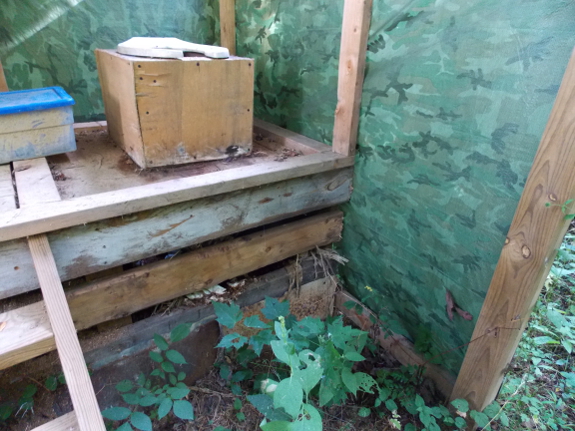
The size of the
composting chamber seems to have been perfect for the two of us
--- the goal is to fill one chamber every year so that by the time
we use up the third chamber, the first is ready to empty.
Our original chamber started looking pretty full a month or two
again, but summer weather also prompted rapid decomposition, so
the contents have sunk down at the same rate we've added to
them. We've used up an entire bin full of sawdust to fill this chamber,
meaning that our finished compost will actually consist primarily
of rotted sawdust and will presumably be quite good around the
base of trees.
I guess I had more to
say about humanure than I thought I did. Who knew!
Thank you Darren and Jake for the
comments on our DIY
Kill Cone alternative.
I always hold the head of
each bird until it bleeds out, but some chickens have a lot of fight
and wiggle their way free and back up in the bucket.
A few pieces of a 2x4
attached to the inside of the bucket with drywall screws decreases
movement while the chicken is in the bucket and seems like it would
prevent a bird from getting all the way out if you lost hold of its
head.
Jake uses a traffic cone,
which I bet would work better than a bucket if you can find one and
figure out an easy way to mount it at a comfortable height.
Mark and I have been hard
at work this summer developing a second-generation chicken waterer
that makes watering your flock even easier. At long last,
the EZ Miser
is ready to see the light of day!
If you're interested
in the inventing side of the story, check out this post I made about the trial and error process Mark went
through to create an even better waterer. Or just go read about the
EZ Miser itself.
I wish we could give
away waterers the way we do ebooks, but that would break the
bank. Instead, for this first week, I've taken 10% off the
price tag so that our loyal fans can afford to give the new
waterer a try.
And if you leave a note with your order, I'll even
throw in 20 Egyptian
onion bottom bulbs (while supplies last). I've been
saving these bottom bulbs for a special occasion since they're
more mature than the top bulbs I usually give away. You can
start eating the green onions from bottom bulbs nearly immediately
--- just let the plant keep at least half its leaves at any given
time.
We've had an EZ Miser prototype in our pasture for two months now,
and I can't figure out how we lived without it. I hope you
love it as much as we do, and I'll be very grateful if you spread the word
so your friends can get in on the early-bird deal too!
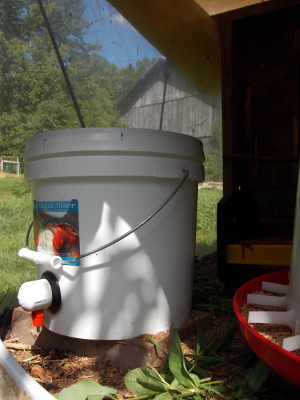 Even though we can't give
everyone a free EZ Miser, Mark and I do want to share this
new-and-improved chicken waterer with at least a couple of our
readers at no cost. So we're combining our 10%
off week with a
contest, with chicken
waterers as the prizes!
Even though we can't give
everyone a free EZ Miser, Mark and I do want to share this
new-and-improved chicken waterer with at least a couple of our
readers at no cost. So we're combining our 10%
off week with a
contest, with chicken
waterers as the prizes!
To enter, email anna@kitenet.net with one or more photos
and your answer to this question: "What do you wish you'd
known about chickens when you first started that you know now?"
Mark and I are going to answer the question ourselves as this
week's lunchtime series, but I suspect our readers have lots to
share that we haven't even thought of.
The fine print: All entries
must reach my inbox by Sunday (August 25) at midnight. Be
sure to send photos one at a time if they're larger than 2 MB
apiece. Mark and I will choose winners based on quality of
the photos and written explanation. All photos and text will
become the property of Anna Hess, which means I might share them
with readers via our blogs or ebooks.
Winners: The grand-prize
winner will receive an EZ Miser, and the second-place
winner will choose between a 3
pack DIY kit or
1 Avian Aqua
Miser Original.
I look forward to receiving your entries and to sharing clean
water with your flock!
| This
post is part of our "I
wish I'd known" lunchtime series.
Read all of the entries: |
I decided we needed a bigger
ATV and the guy at the repair shop agreed.
We worked out a trade where I
gave him the broken ATV and some money and he upgraded us to the
Polaris 700 Sportsman.
After using the Polaris
400 Xplorer for the
summer I started having second thoughts on the 2 cycle engine. It
seemed to be more difficult to start and get warmed up than what I
consider to be normal, and sometimes a guy just needs more power.
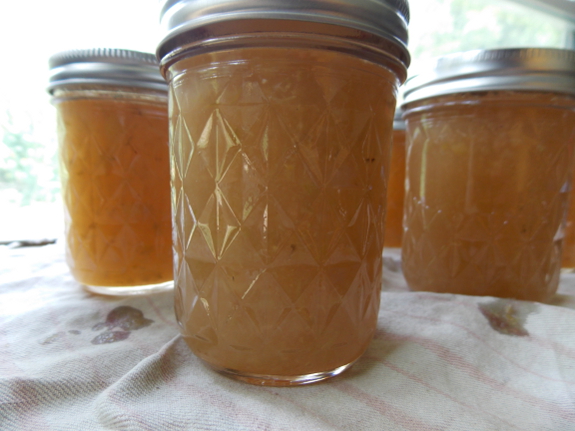
Homemade
apple pectin
works! Which isn't to say that my jam-making experiments
haven't included some growing pains over the last week. For
example, my first try (shown above) didn't gel...so I renamed it
"Peach Syrup" and pronounced it a success anyway.
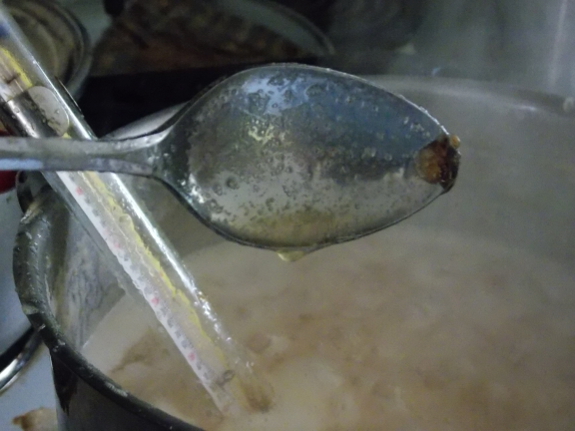
Why didn't Jam 1.0
solidify? Reading up on the topic suggested three potential
problems:
- Too large of a recipe.
Joy
of Cooking recommends starting with no more than 4 cups of
fruit, and I used 4 cups of peach puree plus 4 cups of
apple-pectin juice for Jam 1.0. The trouble with big
batches of jam is that jamming is very temperature-dependent,
and the average home kitchen won't keep the contents of a large
pot as evenly heated as the contents of a small pot. For
Jam 2.0, I split my recipe into two pots, each of which held
only four cups of liquid.
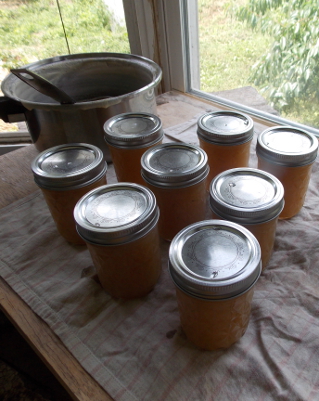 Not enough sugar.
The recipe I was following called for 7 cups of sugar, but that
just seemed extraordinarily high, so I cut it to 4 to match the
amount of peach puree. Joy of Cooking again came to the rescue,
telling me that I need 0.75 to 1 cup of sugar per cup of fruit
(and the apple juice is fruit, remember) if I don't use
low-sugar pectin. (I do want to try our readers'
suggestion of Pomona's
Pectin, but our little grocery store doesn't carry it, I
forgot to look for the item when I was in the big city over the
weekend, and there's not enough time to order it online before
the peaches finish ripening.)
Not enough sugar.
The recipe I was following called for 7 cups of sugar, but that
just seemed extraordinarily high, so I cut it to 4 to match the
amount of peach puree. Joy of Cooking again came to the rescue,
telling me that I need 0.75 to 1 cup of sugar per cup of fruit
(and the apple juice is fruit, remember) if I don't use
low-sugar pectin. (I do want to try our readers'
suggestion of Pomona's
Pectin, but our little grocery store doesn't carry it, I
forgot to look for the item when I was in the big city over the
weekend, and there's not enough time to order it online before
the peaches finish ripening.)- Not enough cooking time.
Joy of Cooking
once again provided facts, telling me that it's necessary to
cook your jam until it reaches 8 degrees Fahrenheit higher than
the temperature
at which water boils at your altitude. (So, I'm
looking for a jam temperature of 217.7 here.) If your
mother-in-law didn't give you a jelly thermometer like mine did
(thanks, Rose Nell!), you can also estimate this temperature by
letting the jam run off the side of your spoon --- when the
drops merge together into a sheet, the jam is ready.
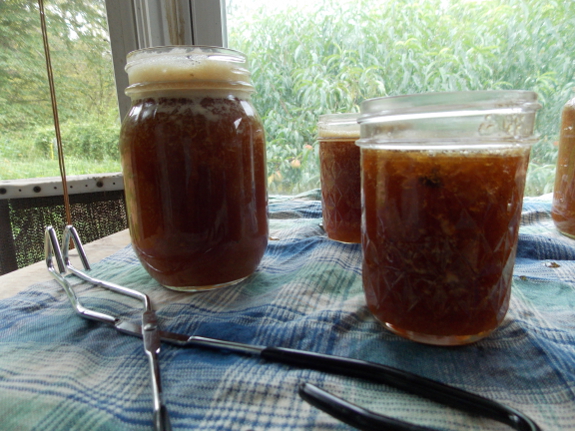
Jam 2.0 went much
better. I brought 2 cups of my apple-pectin juice to a boil,
simmered for 5 minutes, then added 2 cups of pureed peach, 3 cups
of sugar, and 2 tablespoons of lemon juice. Then I brought
the mixture back to a boil and simmered for about fifteen minutes
until the temperature seemed right. After 10 minutes in the
hot-water-bath canner, the jars were full of jam that stayed put
even when I turned the jars sideways!
I'm not 100% happy
with the results, but Jam 2.0 is definitely an improvement.
I now see what various commenters meant when you said that this
kind of jam has a "cooked taste." Sure enough, the bit of
jam that didn't fit in the jars and that Mark and I tasted with
dinner was more like candy than fruit (no wonder, since the
cooked-down jam included half a cup of sugar per cup of finished
jam!). And Jam 2.0 is more solid than I really needed,
probably because I hadn't done the altitude calculations before
writing this post and cooked my jam to 220 degrees instead of
218. But perhaps that's a sign I could cut back the sugar a
bit more since this recipe gelled so well?
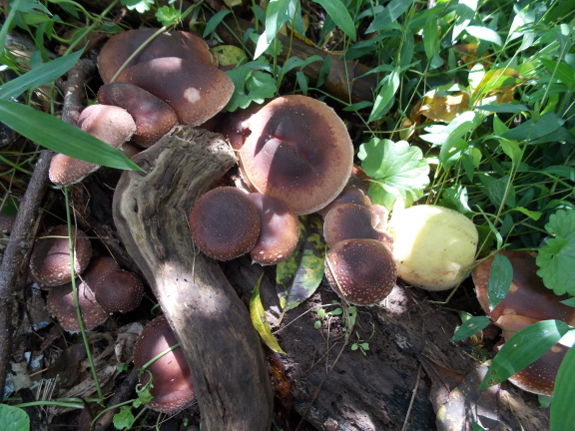
Since it's so hard to
tell when a white peach is perfectly ripe, I've been harvesting
the drops each morning, which have been amounting to about a third
of a bushel of peaches per day. I figure this amount will
hold out until the end of the week, so I'll probably make at least
one more try at jamming. But first, we'll eat up these
shiitakes that popped up in one of the logs I had resting in the
peach tree's shade.
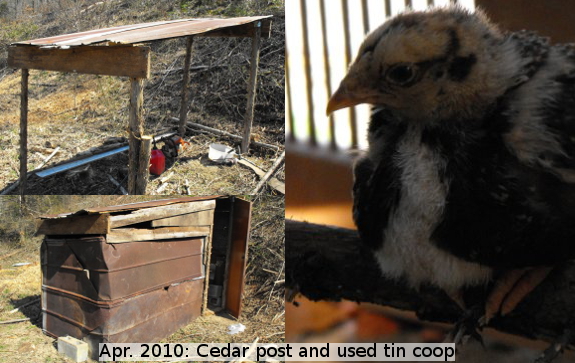
When I asked Mark
what he wished he'd known about chickens when we first got
started, his immediate answer was: "I wish I'd realized coops need
to be big and accessible." He detests our current coops and
is looking forward to getting back to work on our Starplate
coop in the
near future.
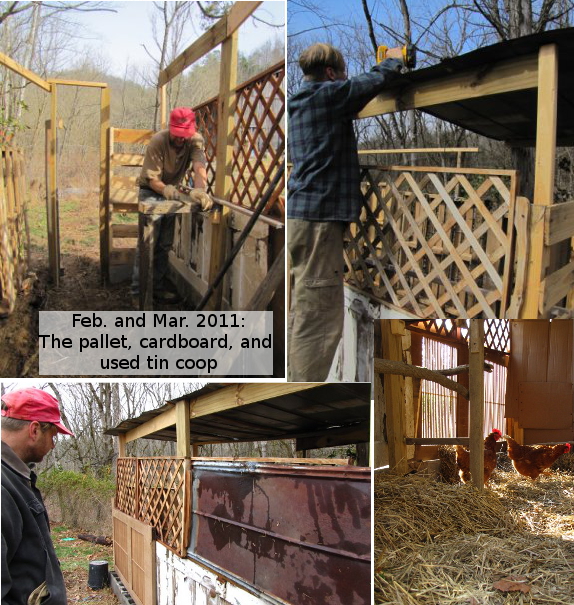
I'm not as judgmental
about Mark's early coops as he is --- when you ask your husband to
build a chicken coop for $10 or less, any serviceable result
counts as a success in my book. But I agree that it's much
easier on the chicken owner if a wheelbarrow will fit through the
door, if you don't hit your head inside, and if nest boxes open to
the outside so you don't even have to enter during daily egg
runs. All of these factors are really for the farmer,
though, since I've noticed that chickens are mostly interested in
quality of the roosts, safety from predators, and how quickly they
can get outside to hunt down bugs.
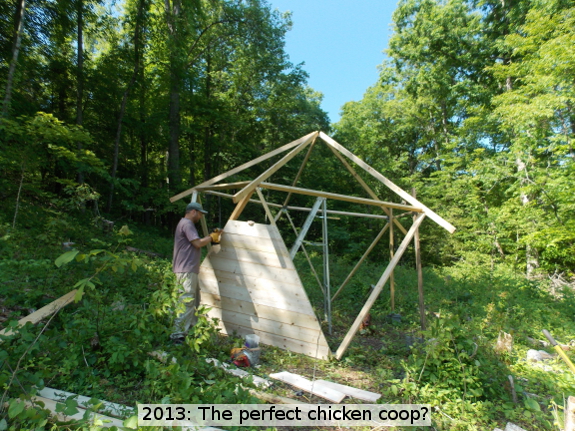
You
can read my wish list for the perfect coop here, and we'll keep you
posted as we finish up version 3.0 this fall. In the
meantime, I'd love to hear your take on the perfect chicken coop,
either in the comments or as an entry in our chicken
contest.
Is there a design feature I've missed?
| This
post is part of our "I
wish I'd known" lunchtime series.
Read all of the entries: |
Our shipping department was
in full swing today taking over the front porch.
Thanks to everybody who
ordered the new and improved EZ
Miser chicken waterer.
We finished up the first
batch of orders today and will be shipping them out tomorrow.
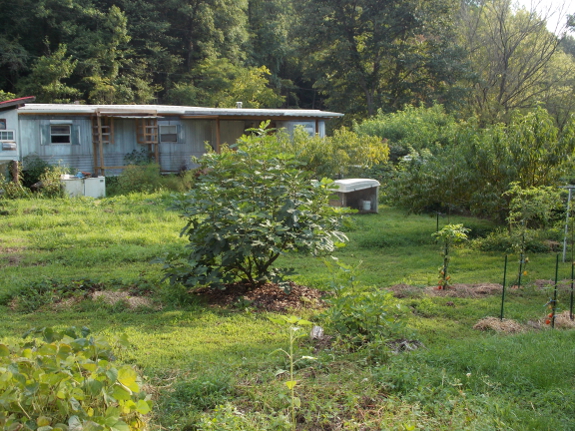
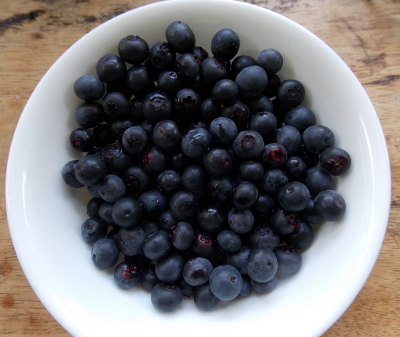 Mom is a New-England expatriate, so the
summer that seemed so strange to me was reminiscent of her
childhood. She predicts we'll see our first frost very early
this year --- September 21.
Mom is a New-England expatriate, so the
summer that seemed so strange to me was reminiscent of her
childhood. She predicts we'll see our first frost very early
this year --- September 21.
What do you think? To make guessing easier, our average
first-frost date is October 10. I'm hoping we'll stave off
frost for as long as possible since we've yet to taste our first
fig of the year and the tree is loaded.
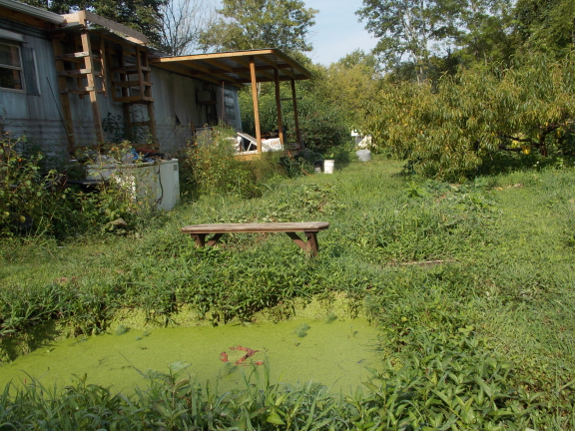
We've had so much
rain recently that our experimental
pond has
overflowed its banks, spreading duckweed throughout the back
garden. Isn't it astonishing how
quickly duckweed reproduces?
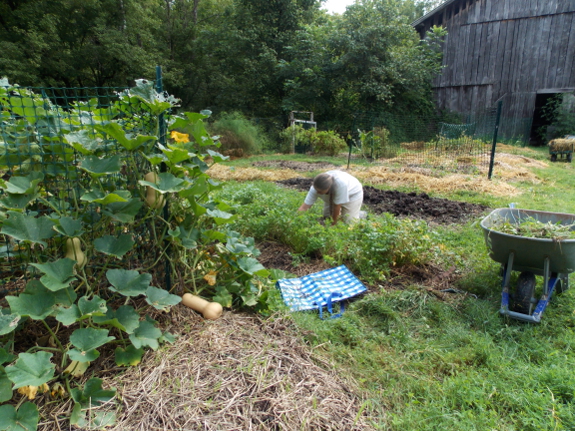
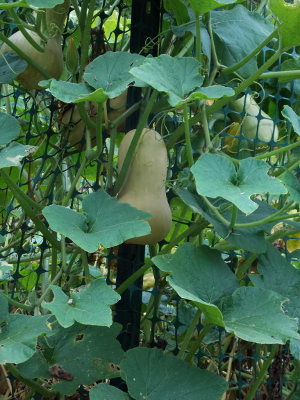 In the vegetable garden, Kayla has been doing over half
my work for the last month or two. I feel a bit guilty when
she's out there weeding instead of me, but I always find plenty of
other work to do. Apparently, gardening time is like a pot
of soup --- you'll fill it all the way to the top no matter how
much space/time is alloted. Or maybe it's just the
astonishing amount of fruit needing processing this summer that
has used up all that spare time.
In the vegetable garden, Kayla has been doing over half
my work for the last month or two. I feel a bit guilty when
she's out there weeding instead of me, but I always find plenty of
other work to do. Apparently, gardening time is like a pot
of soup --- you'll fill it all the way to the top no matter how
much space/time is alloted. Or maybe it's just the
astonishing amount of fruit needing processing this summer that
has used up all that spare time.
I know this post is
disjointed, but all three elements somehow join together in my
head, meshing in some odd way along with my fuzzy recollection of
the space-time continuum. Or maybe I just really wanted to
post a bunch of pictures and needed words to go with them.

 While Mark's
chicken learning curve involved coops, the top of my list
was food --- not food for the chickens, but food for us. We
started out with twenty hens, then quickly scaled back to half a
dozen because we didn't know what to do with so many eggs.
Since then, I've learned the value of pastured eggs, meat, and broth,
and our consumption has increased dramatically.
While Mark's
chicken learning curve involved coops, the top of my list
was food --- not food for the chickens, but food for us. We
started out with twenty hens, then quickly scaled back to half a
dozen because we didn't know what to do with so many eggs.
Since then, I've learned the value of pastured eggs, meat, and broth,
and our consumption has increased dramatically.
Part of my culinary
journey involved coming to the conclusion that eggs and fats from
pastured meat are a health food, not a heart attack waiting to
happen. I won't go into the details in this post because I
suspect you either believe firmly that all cholesterol and animal
fats are unhealthy, or you already agree with me, and nothing I
write is likely to change your mind. Suffice it to say that
some people believe that omega-3s from pastured animal products
are a good kind of fat and that eggs raise your HDL (good)
cholesterol. If you're a believer, broth from pastured
chickens will be on your list of super foods, along with
orange-yolked eggs, garlic, and leafy greens. (That's my
personal list; yours may vary.)
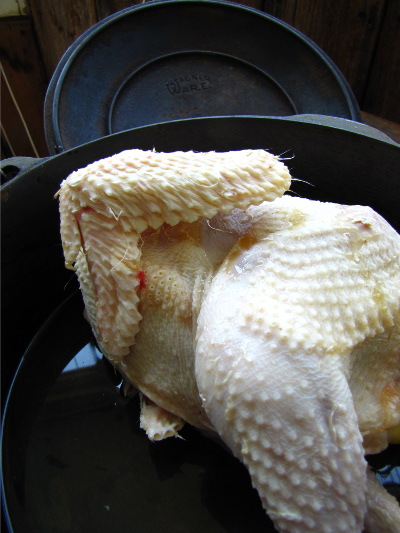 Even after making that
mental leap, though, we've had to learn how to cook with pastured
chicken meat and how to incorporate more eggs into our
meals. The latter is the easy part since a fried egg is a
quick way to add protein and round out a lunch when leftovers
don't quite stretch to feed us both. Combining occasional
eggy lunches and dinners with our three eggs apiece for breakfast,
Mark and I probably go through nearly five dozen eggs per week
nowadays.
Even after making that
mental leap, though, we've had to learn how to cook with pastured
chicken meat and how to incorporate more eggs into our
meals. The latter is the easy part since a fried egg is a
quick way to add protein and round out a lunch when leftovers
don't quite stretch to feed us both. Combining occasional
eggy lunches and dinners with our three eggs apiece for breakfast,
Mark and I probably go through nearly five dozen eggs per week
nowadays.
I'm still working on
the best ways to cook meat from our heirloom, pastured chickens
since the flesh tends to be stronger tasting and a bit tougher
textured than meat from Cornish Cross, even if they were raised on
pasture. (The more-mainstream Cornish Cross don't forage as
well as our chickens, so I assume their meat is less nutritious,
which is one of the reasons we've avoided the breed.) You
can read some of my heirloom-chicken cooking experiments here --- most have been
delicious.
Even though I'm a bit
afraid to open up the nutritional debate here, I'm still curious
to hear from our readers. Have your tastes and beliefs about
pastured animal products changed as you brought chickens to your
homesteads and plates?
| This
post is part of our "I
wish I'd known" lunchtime series.
Read all of the entries: |
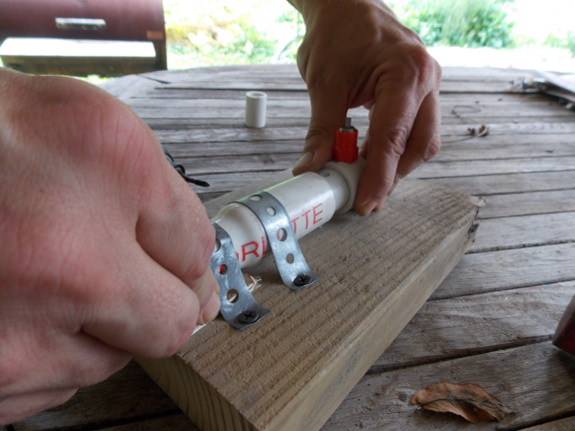
The EZ
Miser launch has been quite an experience for us, very
different from our original launch
of the Avian Aqua Miser. In December 2008, we barely
had a web presence, and we sold one or two waterers per week for
the first little while. That gave Mark plenty of time to
work the kinks out of mass production.
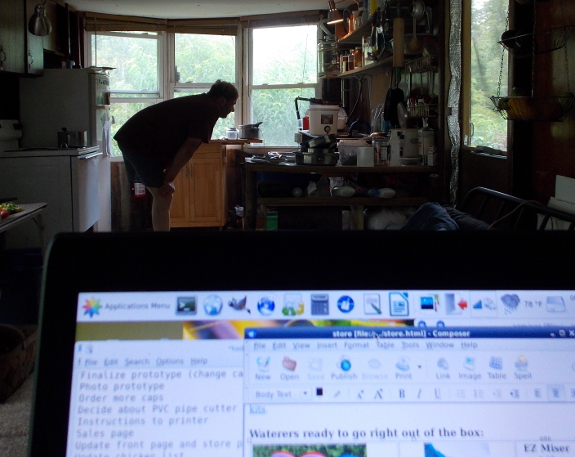
In contrast, this
time around, I spent all day Monday at the computer, just fielding
emails, and Mark's working as fast as he can building EZ
Misers. That's why I'm posting instead of Mark this
afternoon --- his brain power is just about used up from days of
tweaking and figuring things out. (Plus, he's at the post
office mailing two ATV-loads of EZ Misers.)
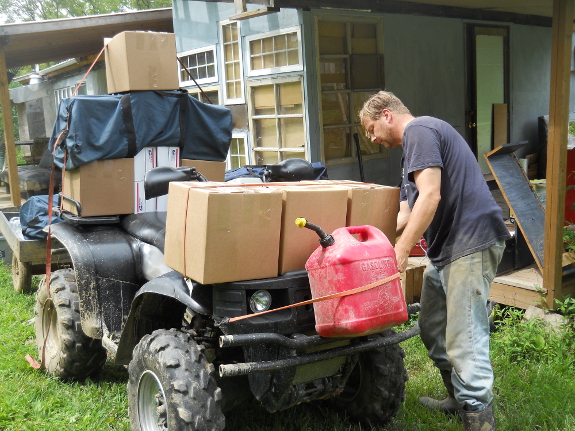
I suspect Mark will
have all of his jigs (Charlotte and sisters) up and running in a
week or so, at which point he'll be able to stop testing each
waterer and start delegating more of the workload. We
appreciate all the business since it will allow us to keep Kayla
employed all winter!

This is what I look
like when I accidentally take a picture of myself running away
from the bee hive after sticking a camera underneath and
disturbing about a hundred bees who were sheltering there since
they didn't fit inside.
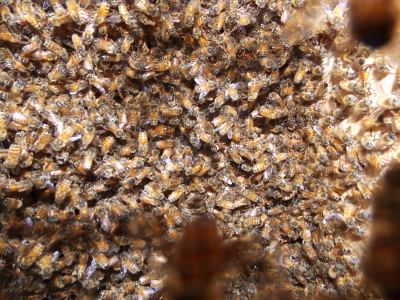 The smaller photo is the picture I took up
through the hive bottom before the flash set the bees off.
That's right, our strongest
hive has already partially drawn out the comb on their
fourth Warre box (equivalent to a Langstroth super in size).
I was alerted to the congestion by the now-typical
bearding at the hive entrance, which brings me to my
conundrum of the day.
The smaller photo is the picture I took up
through the hive bottom before the flash set the bees off.
That's right, our strongest
hive has already partially drawn out the comb on their
fourth Warre box (equivalent to a Langstroth super in size).
I was alerted to the congestion by the now-typical
bearding at the hive entrance, which brings me to my
conundrum of the day.
I definitely need to
add a new box to this hive since the fall nectar flow just keeps
getting better. The question is, do I cut
down a Langstroth box to make a fifth Warre box (relatively easy since I
ordered extra top bars this summer, but potentially heavy lifting
to get a new box underneath); do I take the unused fourth box from
the hive that  swarmed this spring (easy, but risks
bothering that hive twice for no reason if the nectar flow
continues long enough that they need a fourth box despite their
slow start); or do I harvest one box of honey from the strong hive
and then put the empty back underneath? I was leaning toward
option one until I realized how hard it would be to lift up three
full (and one partially full) Warre boxes to get a new one
underneath. All suggestions (except for Huckleberry's
admonition that we should all just finish our naps) are
appreciated.
swarmed this spring (easy, but risks
bothering that hive twice for no reason if the nectar flow
continues long enough that they need a fourth box despite their
slow start); or do I harvest one box of honey from the strong hive
and then put the empty back underneath? I was leaning toward
option one until I realized how hard it would be to lift up three
full (and one partially full) Warre boxes to get a new one
underneath. All suggestions (except for Huckleberry's
admonition that we should all just finish our naps) are
appreciated.

Like many
homesteaders who weren't raised to the task, slaughtering our own
meat animals was one of the thorniest issues Mark and I faced as
newbies. Despite our trepidation, though, we've found that
taking our meat all the way from egg to table ourselves has given
us a mystical (Mark's word) connection to our nutrition that we
never felt before.
 Which isn't to say the
journey was easy. The first chickens I helped kill were
pre-Mark, and I can't recall if any of them actually got
eaten. Each rooster had a name and they were all too old for
the flesh to be easily palatable by the time we finally did the
deed. The whole event was traumatizing, akin to my childhood
experience of naming the calves we were going to sell for meat.
Which isn't to say the
journey was easy. The first chickens I helped kill were
pre-Mark, and I can't recall if any of them actually got
eaten. Each rooster had a name and they were all too old for
the flesh to be easily palatable by the time we finally did the
deed. The whole event was traumatizing, akin to my childhood
experience of naming the calves we were going to sell for meat.
A couple of years
later, I had met Mark and we were considering raising broilers for
the first time. Some
friends kindly agreed to let us come "help" them slaughter their
chickens in exchange for a tutorial, and even though we
learned a lot from gutting the birds, the three throats I managed
to slit felt like three too many.
When
the time finally came to kill our own birds, Mark and I made
a deal --- he would kill the chickens (the really hard part
emotionally) and I would do everything else. We got the
first bird in the kill bucket, Mark thanked it for the meat it was
going to provide, and then he slit its throat. By the time
the feathers were off, I was able to consider the pink thing in
front of me to be food worth processing, not an animal I'd
murdered in cold blood.
You can tell the
emotional level of a task by the behavior of our pets, and
chicken-killing is no exception. During our first few
slaughtering days, Lucy danced around excitedly and had to be tied
up, an indication that Mark's and my stomachs were tense from the
ordeal. Lately, though, Lucy acts like a lady, even (mostly)
leaving the entrails bucket alone when I go inside to put a
newly-cleaned chicken into the fridge. Chicken-killing day
isn't our favorite part of the week, but it's no longer dreaded,
and I no longer have to wait several days until the butchering
images leave my mind before I can partake of the meat.
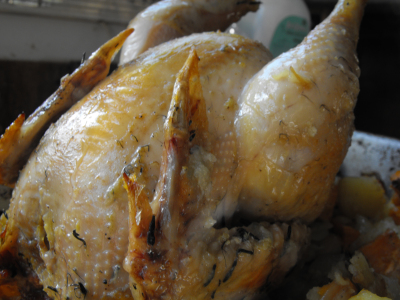 Speaking of that meat ---
it seems to taste better for having been produced with our own
four hands. Adding meat animals to our homestead has turned
our land from a garden that we tend to as outsiders into an
ecosystem that we're part of. Mark sums it up this way: "If
you kill the chickens you eat, you're part of the food chain."
Speaking of that meat ---
it seems to taste better for having been produced with our own
four hands. Adding meat animals to our homestead has turned
our land from a garden that we tend to as outsiders into an
ecosystem that we're part of. Mark sums it up this way: "If
you kill the chickens you eat, you're part of the food chain."
I don't know if
there's a way to fast-forward through the more difficult parts of
learning to slaughter your own meat animals (short of being raised
among people who consider the task no big deal). But I would
recommend that carnivorous homesteaders learn to butcher their own
meat sooner rather than later. I try to steer clear of the
spiritual world whenever possible, but I have to admit that Mark's
right --- killing chickens, in the right mindset, is a mystical
experience.
| This
post is part of our "I
wish I'd known" lunchtime series.
Read all of the entries: |
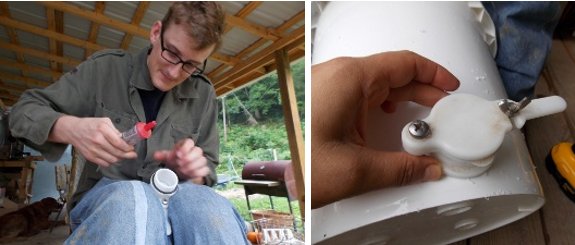
Thanks to my cousin
Ben we got our honey gate installed today.
Honey collects in the food
grade bucket and the large valve makes jar filling easier and faster.
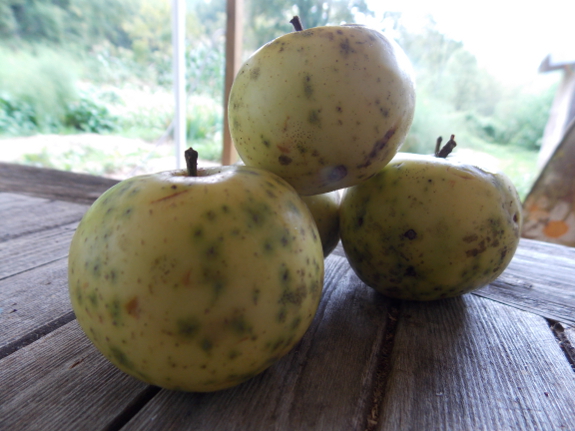
I
turned most of the apples Kayla gave me into pectin juice for
jam, but a few looked more ripe and ready for a taste
test. I was surprised by the sweet-tart, explosive flavor of
the apples and asked Kayla what kind they were. She replied
that the tree was old and no one knew what it had been.
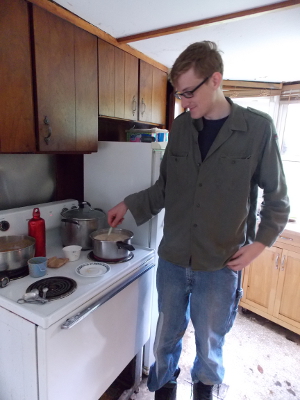 Even with the variety unknown, I could
propagate the tree by grafting
a twig onto one of our current apple trees or onto rootstock, but
I had a hunch I could identify the fruit. Last summer,
Bradley sang the praises of Summer Rambo, which is reputed to
ripen at this time of year and which seems to be a local
favorite. Could the unknown apple be Summer Rambo?
Even with the variety unknown, I could
propagate the tree by grafting
a twig onto one of our current apple trees or onto rootstock, but
I had a hunch I could identify the fruit. Last summer,
Bradley sang the praises of Summer Rambo, which is reputed to
ripen at this time of year and which seems to be a local
favorite. Could the unknown apple be Summer Rambo?
Kayla independently
came to the same conclusion while on her first-anniversary trip to
North Carolina. She and her husband stopped at a fruit stand
along the way and saw some apples she thought looked just like her
own. The variety? Summer Rambo.
I installed a Summer
Rambo in my high-density
planting last fall, so in a year or two, I'll be able to
compare a homegrown Summer Rambo to Kayla's mystery fruits.
In the meantime, I thought I'd ask our readers --- if you grow
Summer Rambo, do the apples at the top of this post look familiar?
(The other photo is
Mark's cousin Ben helping me make jam out of some of the
apple-pectin juice. This second round worked like a
charm! We stopped cooking after 18 minutes when the
temperature hit 218 degrees, and the jam was lighter in color with
less of a cooked taste than last
time. I'm definitely getting the hang of cooked jams!)

 The response to our "I
wish I'd known" contest has been overwhelming! I'm posting entries one per
day on our chicken blog, and have decided to let
the public decide which one is the winner.
The response to our "I
wish I'd known" contest has been overwhelming! I'm posting entries one per
day on our chicken blog, and have decided to let
the public decide which one is the winner.
To be involved, stay tuned to either our chicken blog or Avian
Aqua Miser's facebook page over the next week
to see all the entries, then comment (or just push the like button
on facebook) to cast your vote. You can vote for as many
different entries as you want, and the one with the most
comments/likes will win! (So if you're rooting for a
particular entry, be sure to tell your friends to drop by and vote
for it too.)
I'm not sure what the
voting deadline will be because all of the entries aren't in
yet. So, don't worry, I'll remind you here when we're
getting near the end of the voting period.
 Here are the first entries, with many more to
come:
Here are the first entries, with many more to
come:
- "I wish I'd known chickens were so easy."
- "Chickens are hard to contain."
- "I
wish I had known how fabulous chicken poop was for garden
fertilizer."
And, don't forget,
there's still time for you to enter and win a free EZ Miser!
| This
post is part of our "I
wish I'd known" lunchtime series.
Read all of the entries: |
Two things I like about the Polaris 700
Sportsman are related to
the engine.
The first is an engine brake.
As you let off the gas some sort of braking gizmo in the engine
brings the ATV to a full stop. I barely need to use the regular brakes
anymore, but what I like most is the increased safety. Sometimes Lucy
wants to stop in front of me for a quick smell check where she pauses
and puts her nose in the air. The engine brake decreases stopping
distance by a considerable amount.
Engine noise is the next
thing I like compared to the 400
Polaris. I guess I prefer
a more deep, throaty engine to the 2 cycle whine that sounds too much
like a chainsaw for my audio comfort level.
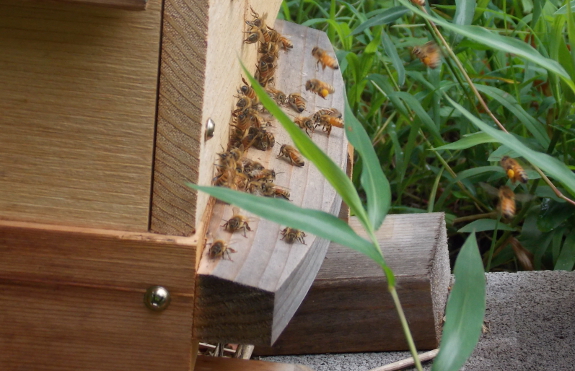
You'd think that
since we've had bees for over four years now, we would have
harvested a lot of honey. Unfortunately, since I'm
stubbornly refusing to use chemicals in the hives, it's been quite
a learning curve, and this is only the second year I've gone to
steal honey from the bees.
The first time around
was in 2010. Our bees had arrived as a package over a year
before, so in June I figured I could take any honey they had left
over from the winter. Despite a learning
curve, we ended up
harvesting about four gallons of honey from four hives that
June.
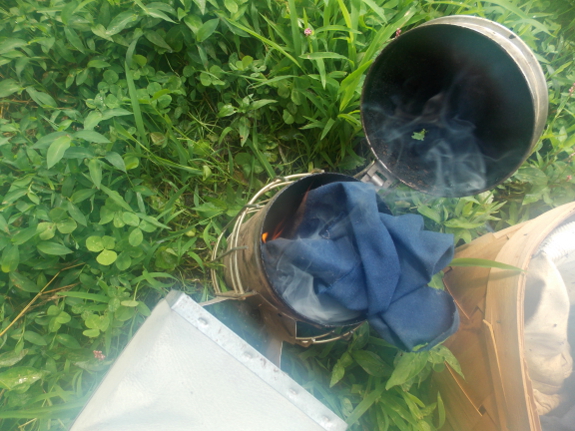
Unfortunately, my
mistake of trying to keep mainstream bees without chemicals killed
off three of the hives the following winter. I split the
remaining hive in 2011, which meant the bees were busy rebuilding
and didn't have time to make extra honey for their
beekeeper. And then both of those hives died, so last year I
started a new package again (this time of bees that had been
raised chemical-free). But I'd also changed over to Warre
beekeeping methods, so I allowed those bees to swarm...which
slowed them down yet again.
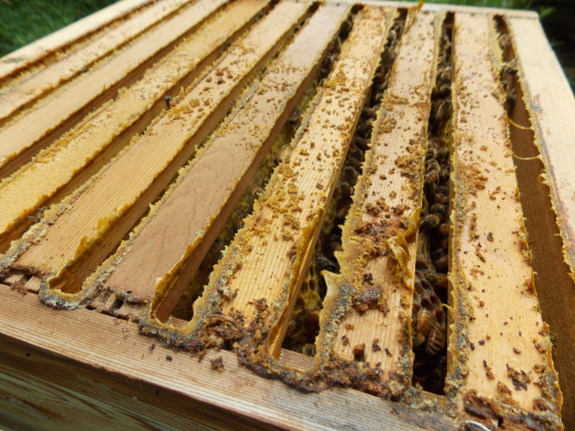
Which is all a long
way of explaining why I'm still making basic beginner mistakes in
the honey harvest department. I had decided to take
a box of honey off our busiest hive, but when I removed the
roof, even after smoking, there seemed to be a lot more bees buzzing around
than I thought there should have been. This was my clue to
pull up a frame and make sure the box was full of honey only, but
I blithely took off the box without checking, shut the hive back
up, and carried my haul halfway back to the trailer.
There, I finally
pried up a frame. The first two frames were full of pollen
and honey, and I set them aside. But the third frame was
covered with capped brood, and so was the fourth! Uh
oh. No wonder the bees were pissed off, buzzing me despite
having been smoked and carried away from home base.
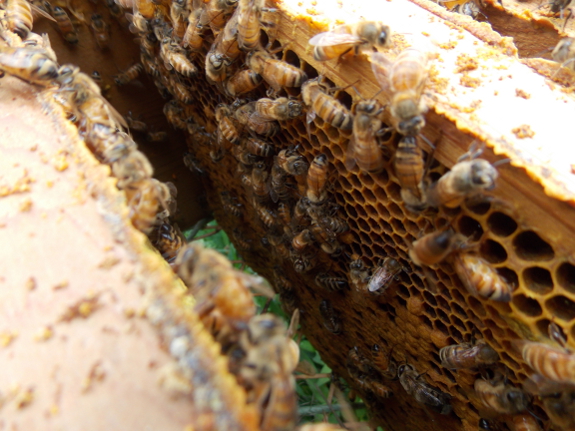
Even though this all
makes sense as I write it, you have to pretend you're me, alone on
the farm (Mark was at the post office) with bees everywhere and
very little memory of what you did last time you harvested
honey. I probably should have just put everything back, shut
the hive up, and dealt with it later once the bees calmed
down. But instead I figured I would first take one of those
empty boxes from the less-strong Warre hive so the first hive
could maintain their building streak.
The trouble is, I smelled like angry bees, so when I went over to
the other hive, they quickly got riled up, and then got angrier
when I could barely lift the hive off the empty box on the
bottom. As I struggled to put the occupied boxes back in
place, guard bees came streaming out of the hive and one stung me
on each knee. In a perfect world, I could have stepped back
after the first sting, but I had to get the hive back on its base
so it wouldn't tip over, and by the time that happened, a dozen
bees had latched onto each knee, and many were managing to sting
straight through my jeans.
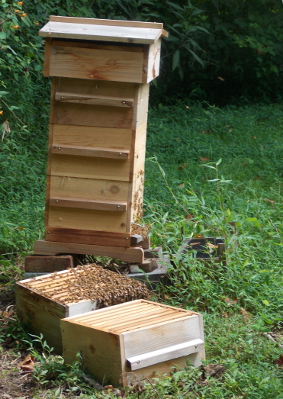 So I ran back to the
trailer, batting at my legs, then rushed through room after room,
brushing off bees in each space and shutting the door so the angry
insects couldn't follow me. Out the other door to brush off
more bees on the porch, then back into the trailer to brush off
the last few bees and pull on another pair of pants and our spare
bee suit to mask the alarm smell.
So I ran back to the
trailer, batting at my legs, then rushed through room after room,
brushing off bees in each space and shutting the door so the angry
insects couldn't follow me. Out the other door to brush off
more bees on the porch, then back into the trailer to brush off
the last few bees and pull on another pair of pants and our spare
bee suit to mask the alarm smell.
Too worn out (and
bee-shy) to do much work on the busy hive I'd begun with, I simply
took off the top and quilt, plopped on the empty box and then the
box of brood, closed the hive back up, and returned to the house
to crush the two frames of honey I'd taken out of that box before
realizing it was full of brood.
I'm not sure why the
top box of our busiest hive was full of brood --- bees are
supposed to start work at the top and move down into the new boxes
I'd put underneath. But nature doesn't always work the way
books tell you it does, and the top box was definitely chock full
of brood. Since the hive is now too heavy to lift up,
allowing me to nadir new boxes underneath, I'll just keep adding
empties to the top if the bees continue to need the space.
Come spring, the colony will be smaller, the bees will have moved
out of most of the boxes, and any honey left should be much easier
to harvest. Maybe by then I'll be able to harvest honey
without making stupid mistakes and getting stung.
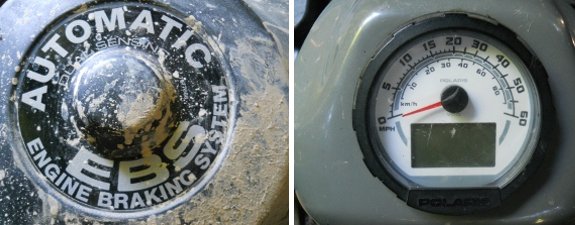
Another thing I like about
the Polaris
700 ATV is the lack of a
clutch.
The sensation of engine
braking feels similar to rapid down shifting and maybe turning control
of the clutch over to a computer makes that possible.
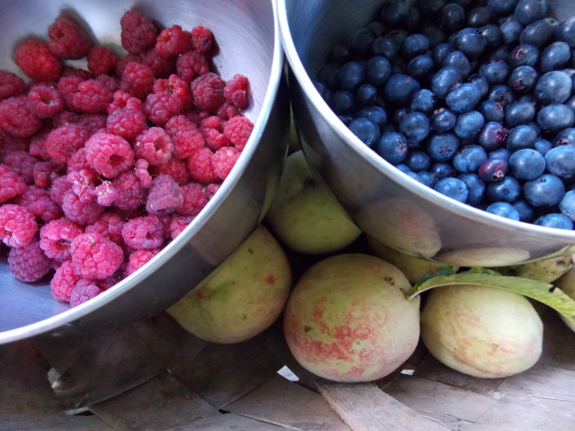
I've always felt it
was too much effort to keep track of yields if a crop isn't
harvested all at once, so I don't know for sure how much fruit our
kitchen peach produced this year. My best guess is about
four bushels, which is just about average for a mature peach and
which feels like a lot.
Since I ran out of
freezer room (having saved some space back for more green beans
and soup), I did a lot of experimenting with alternative
preservation techniques (compared to our tried-and-true peach
leather). I canned
a load of peach chunks (which look good) and a load of peach
sauce (in which I didn't leave enough head room, resulting in an
eruption that ruined the seal on five jars during cooling).
And then there were the jams.
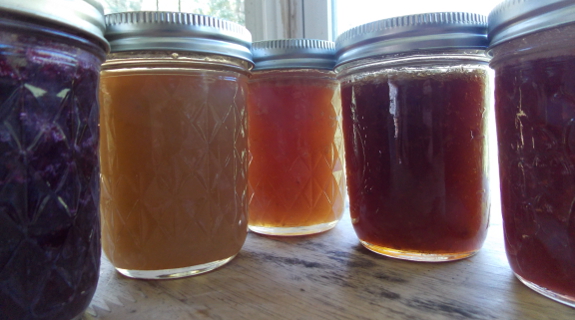
As I've written
previously, it took some experimentation to figure out how
to make cooked jams with no store-bought pectin, and I'm
still working the kinks out of the process. This week's
experiment involved lowering the sugar levels, and also mixing in
smaller amounts of other fruits. I learned that pure white
peaches will make a slightly-runny jam with two cups of sugar per
batch (two cups of peach puree and two cups of apple-pectin
juice), but I wouldn't want to go any lower with the sugar
content if I expected my jam to set.
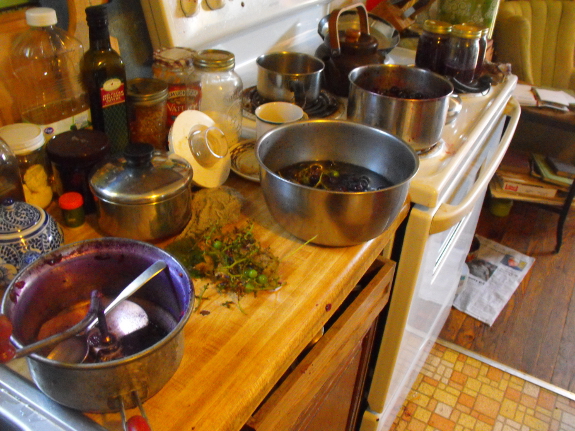
Maggie gave
me two cups of pulpy grape juice that she had laboriously
harvested from her Concords, and I turned those into a batch of
jam as well. Adding two cups of apple-pectin juice and two
cups of sugar resulted in a fast, thick jam, making me think that
I could have cut back the sugar content. Or, better yet,
mixed some of the grape juice with peach pulp for a tangy, well-set jam
containing less sugar.
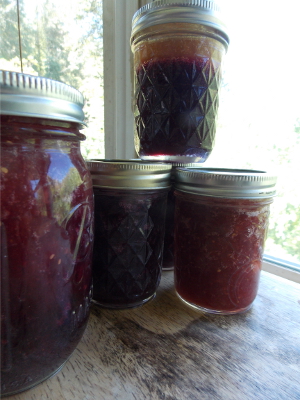 Since I was making a batch of peach jam at the same
time as the grape and didn't have quite three cups of the finished
grape jam, I added a layer of peach on top of each jar for a very
unique jam presentation. This jam layering didn't work as
well with less-dense jams, though, so be forewarned.
Since I was making a batch of peach jam at the same
time as the grape and didn't have quite three cups of the finished
grape jam, I added a layer of peach on top of each jar for a very
unique jam presentation. This jam layering didn't work as
well with less-dense jams, though, so be forewarned.
In the midst of all
this peach-and-jam frenzy, I let the red raspberries and
blueberries start to get away from me. So, Saturday, I mixed
peaches and berries to make a beautiful, slightly-tarter jam (even
though the sugar content was my now-standard two cups of sugar per
four-fruit-cup batch). The red-raspberry/peach and
blueberry/peach jams are still setting up, so I don't know how
well they gelled, but they sure did taste delicious when I licked
out the pans, and the colors are stunning.
Although all of this experimentation has been fun, I'm definitely
glad the last few peaches are in the fridge for fresh eating, with
none left on the tree. I can't imagine having more than one
tree producing at the same time, so take heed while planning your
orchard!
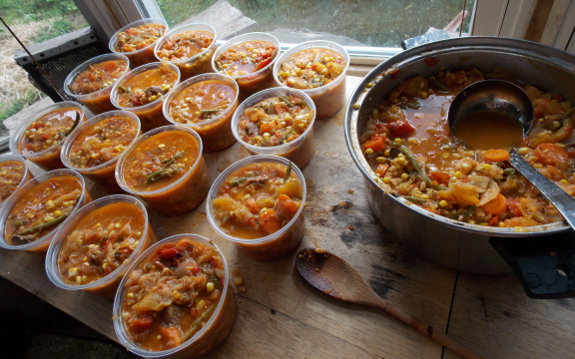
Four years ago
when the tomato blight hit this hard, Anna asked me to pull
out the vines because they were too depressing.
This year, we've been
harvesting what we can to make into soup. Maybe not as much
as last year, but we'll appreciate every nutrient packed morsel in
January.
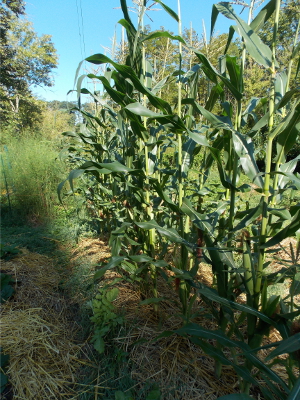 For some vegetables, we have favorite
varieties and don't experiment at all, but for others, I'm still
looking for the type that best suits our farm and palates.
This year, I grew three kinds of sweet corn, and thought I'd share
my results.
For some vegetables, we have favorite
varieties and don't experiment at all, but for others, I'm still
looking for the type that best suits our farm and palates.
This year, I grew three kinds of sweet corn, and thought I'd share
my results.
Legend was not so
legendary as an ultra-early corn, but I have another planting
(pictured here) ripening up in a week or so that might change our
minds. Bodacious (which we've tried before) was good, but
not the be-all-and-end-all corn that our hardware store
proprietor's son said it would be. (I suspect the son liked
the name more than the corn.)
What lived up to the
hype? Mirai 160Y Yellow. As their website explains:
"Supersweet types (SH2) have high sugar for shipping but are tough
and do not have good corn flavor. Sugar Extenders types (SE)
are very tender and have good flavor but are not sweet and
sugary. Types (SU) have old-time sweet corn flavor but are
not tender or sweet. Combining these 3 types of sweet corn
give Mirai customers their truly unique, one-of-a-kind 'Mirai
Experience' of the best taste, flavor and texture available in
sweet corn today." In our own garden and kitchen, a bit of
Mirai corn was sweet enough to turn soup made from blighted
tomatoes into a delicious feast.
Of course, like all
the sweet corns we favor, Mirai is a hybrid, so we can't save the
seeds. And the variety is currently very highly priced --- I
think I spent $4 on 100 seeds. Still, as a special summer
treat, the corn was worth it.

I've been cutting a lot of
PVC pipe lately.
Hack saw, coping saw,
reciprocating and circular saw all paled in comparison to the new Milwaukee
M12 PVC shear cutter.
It uses an ultra sharp blade
with a pierced point design that leaves no burrs.
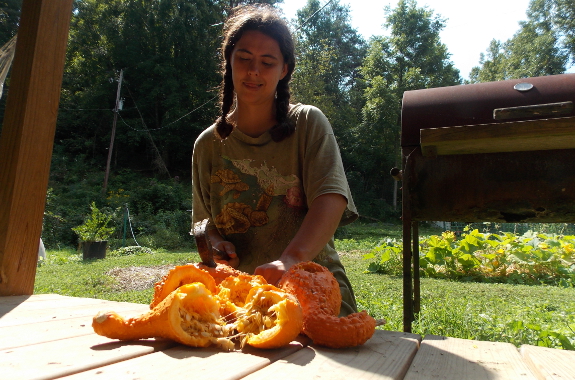
"Isn't there a band
called Smashing Pumpkins?" I asked Mark as I slammed a hammer into
our mature summer squash to extract the seeds.
He laughed at my
pop-culture illiteracy and told me that during World War II,
potential enemy saboteurs would be quizzed on popular culture and
jailed if they failed. I definitely wouldn't make the
cut. I've used up all those brain cells that ought to be
devoted to TV characters and pop-culture icons by memorizing plant
names and bird calls...
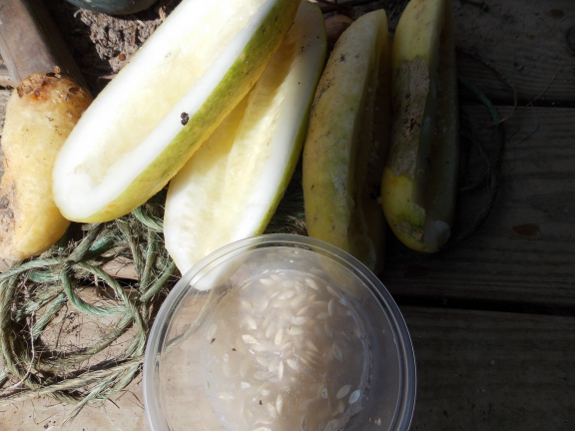
...and the
intricacies of seed saving.
If you'd like to join
the ranks of the terminally uncool, you can learn to save
cucumber and squash
seeds in past
posts. To protect your cool status, though, you'd probably
be better off reading one of those glossy magazines in the
supermarket checkout aisle.
If you sandwich up two 50 pound bags of chicken feed in just the right way it allows enough space to squeeze in a 20 pound bag of chick starter feed.
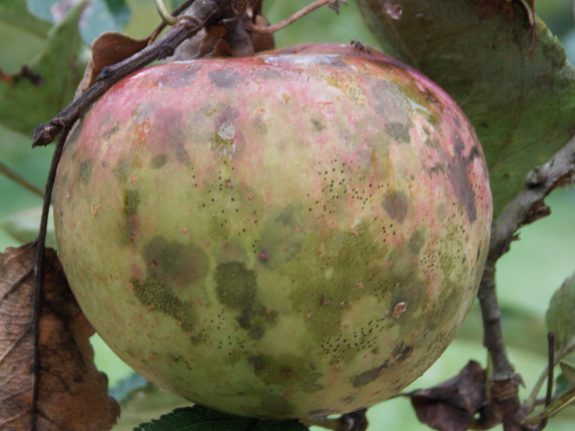
There are so many apple
varieties most of us have never even heard of. But how
do you know which heirlooms to add to your orchard if you only
have written descriptions to choose from?
Since heirloom apples
are one of my obsessions, I keep trying to talk people into
running apple tastings. The apple gurus invariably guide me
toward Monticello's
annual apple tasting, but even though Jefferson gardened in
the Virginia mountains just like me, I can't quite talk myself
into 9 hours of driving (round trip) to taste his apples.
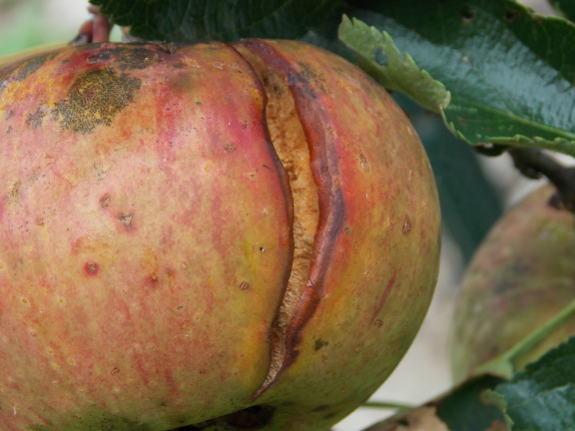
This week, I found
another reason (besides the driving) to try to keep my apple
tastings closer to home. Our most vigorous apple tree is a
Virginia Beauty, and a few years ago we found some Virginia Beauty
apples at a fruit stand to taste. They weren't anything to
write home about, and I stopped being as interested in my own
tree. But this year, my Virginia Beauty finally produced
fruits, a few of which cracked from heavy rains and ripened
early. I took the world's ugliest apple inside and ate it
myself rather than trying to force Mark to overlook its
blemishes...and the fruit was probably the tastiest apple I've
ever eaten!
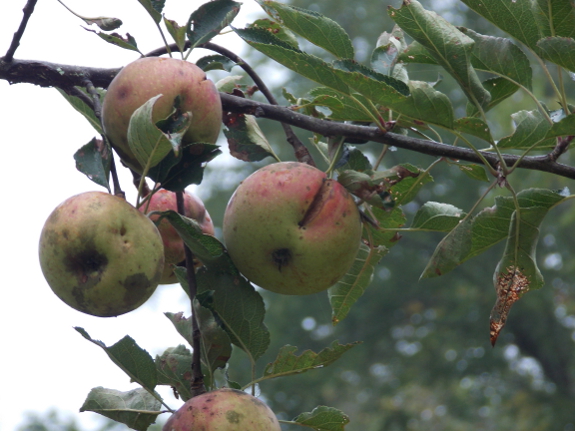
The experience made
me rethink counting on anyone else's apples to give me even a
vague impression of what a variety will taste like. When an
apple tree fights insects and diseases and is fed by rotten wood
and horse manure, its fruits aren't going to taste anything like
those beautiful, sprayed globes from a traditional orchard.
In fact, homegrown tastes much, much better.
So, I'm no longer yearning to attend an apple tasting.
However, if anyone wants to create an online heirloom apple CSA
(just enough to taste of each variety coming in the mail the month
each is ripe), I'll sign up in a heartbeat.
We're still figuring out how
to finish the roof on the Star
Plate chicken coop.
Tune in tomorrow to see how
well our alternative idea for a roof works out.
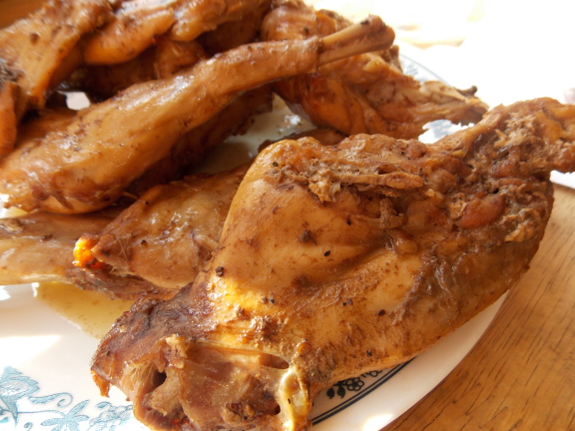
Ever since Shannon
shared some of his rabbit-raising adventures, I've been wanting to
taste rabbit meat. So I was thrilled when a frozen rabbit
showed up on my door step, courtesy of my cousin-in-law's mother,
who had the rabbit given to her in exchange for free legal
services.
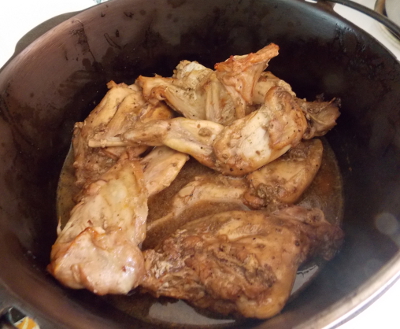
I didn't know
anything about the rabbit --- was it young or old; wild-caught or
farm-raised? So I opted to slow cook it in a Dutch oven at
300 degrees for ninety minutes to ensure palatability. On
Mark's advice, I first marinated the meat in teriyaki sauce (which
I should have done with our failed
squirrel taste test).
The result?
Delicious! The rabbit came parted out, and Mark and I shared
pieces of what would be the breast and wing on a chicken.
Both tasted very much like the relevant parts of a chicken, in
fact, although I thought the rabbit foreleg was much better than
any chicken wing I've ever eaten --- moister and richer in
flavor. The aroma while cooking was also enticing, and I
can't wait to make a broth out of the bones.
That one rabbit
created quite a lot of meat. We've probably got enough left
for another three or four meals for the two of us. While
we're not adding new livestock to our farm anytime soon, this
taste test suggests that rabbits could definitely be on our
culinary list if we found a good source.
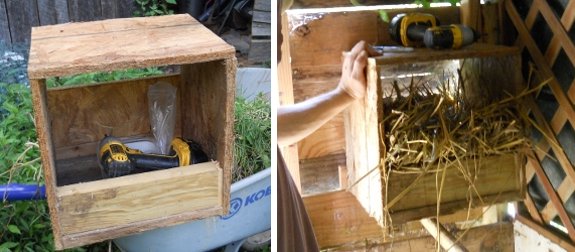
How tall should a nest box be?
We went with 14 inches high
and 13 wide...all from pieces of scrap wood.
Mounting was easy with a
couple of shelf brackets.
 I've been slowly digesting
Gardeners
of Eden, by Dan
Dagget, for the last month or so. Usually, I know what I
think of a book right away, but Gardeners of Eden both inspires me and repels me, making it hard to write a
review. As usual, I'll start with the good parts.
I've been slowly digesting
Gardeners
of Eden, by Dan
Dagget, for the last month or so. Usually, I know what I
think of a book right away, but Gardeners of Eden both inspires me and repels me, making it hard to write a
review. As usual, I'll start with the good parts.
Those of you who have
studied natural resource management have probably heard about the
great divide between preservationists and restorationists.
Preservationists believe that the best thing we can do to any wild
area is to leave it alone, preserving it in its natural
state. Restorationists, on the other hand, believe that we
should actively work to improve problems in the natural world
(perhaps by carrying out prescribed burns, grazing, or timber
cuts). The philosophy of preservationism is found in the
management of most National Parks in the U.S., while
restorationists hold sway over the National Forests.
Dan Dagget started
out as a preservationist (just like I did), and was an
environmental activist in groups including EarthFirst! for
decades. However, over time, he started seeing nearby
ranchers in the West who were producing healthier ecosystems than
were found in neighboring leave-it-alone preserves. Dagget
researched pre-Settlement human impacts on these landscapes and
realized that the land had evolved to depend on a partnership with
humanity. Rare onions and mussels and fishes and birds all
seemed to expand their numbers in areas with thoughtful human
impact, and Dagget concluded we were doing our ecosystems a
disservice by acting like aliens intent only on protecting the
landscape from our own depredations.
 While inspiring from
a permaculture perspective (don't we all want to believe we can
create forest gardens and pastures that will improve the natural
world while feeding us?), I kept finding flaws in Dagget's
logic. For example, Native Americans weren't evenly
scattered across the continent, so doesn't it stand to reason that
certain areas have evolved to prefer lower human impact than
others? And can you really judge the health of an ecosystem
by the population of one endangered species or by the total number
of species present? After all, edges are often lauded for
containing more species than either region they divide, but
ecological studies show that field/forest edges are net sinks for
songbirds since the birds nest in spots with higher-than-usual
predator pressure, resulting in the loss of their offspring and
often their own lives. Could some of Dagget's
supposedly-topnotch ranches have a similar effect going on?
While inspiring from
a permaculture perspective (don't we all want to believe we can
create forest gardens and pastures that will improve the natural
world while feeding us?), I kept finding flaws in Dagget's
logic. For example, Native Americans weren't evenly
scattered across the continent, so doesn't it stand to reason that
certain areas have evolved to prefer lower human impact than
others? And can you really judge the health of an ecosystem
by the population of one endangered species or by the total number
of species present? After all, edges are often lauded for
containing more species than either region they divide, but
ecological studies show that field/forest edges are net sinks for
songbirds since the birds nest in spots with higher-than-usual
predator pressure, resulting in the loss of their offspring and
often their own lives. Could some of Dagget's
supposedly-topnotch ranches have a similar effect going on?
Overall, I felt like
Gardeners of Eden was a thought-provoking book that suffered
from a bit too much pseudoscience. If you're willing to read
it with a critical eye --- especially if you live in the American
West --- you'll probably get a lot out of the text and beautiful
photos. But I'd hesitate to pass the book on to a
less-than-critical reader.
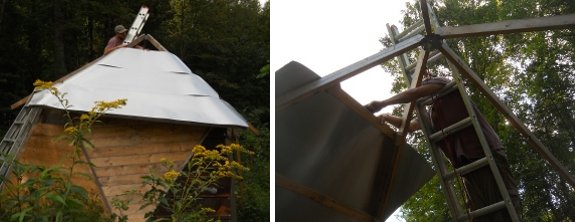
We made some progress on the Star
Plate chicken coop roof today.
Choosing a safe spot for the
ladder is the tricky part.
We're using a roll of 28 inch
flashing material that gets overlapped at each seam.
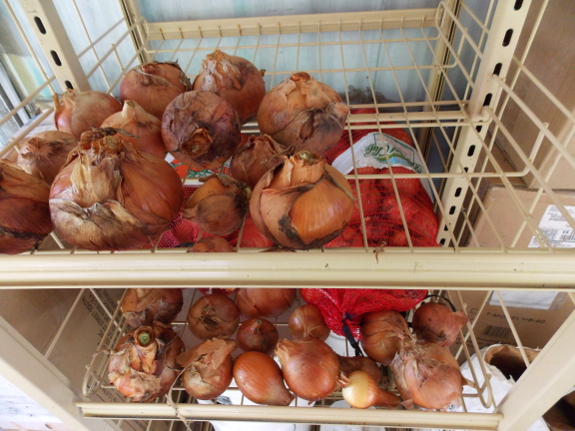
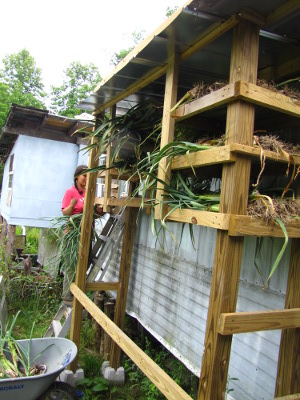 Last
year's drying tower was a vast improvement over my
cobbled-together vegetable-curing stations of previous years, but
the racks were still problematic. The worst issue was access
--- climbing up a ladder with baskets of heavy produce is
dangerous and tiring, which led to me ignoring the contents of the
racks until absolutely necessary. The vegetables also
sometimes got re-wet by rain splashes, and I felt the roof might
have been a bit too close to the top shelves, causing the contents
to cook on very hot days.
Last
year's drying tower was a vast improvement over my
cobbled-together vegetable-curing stations of previous years, but
the racks were still problematic. The worst issue was access
--- climbing up a ladder with baskets of heavy produce is
dangerous and tiring, which led to me ignoring the contents of the
racks until absolutely necessary. The vegetables also
sometimes got re-wet by rain splashes, and I felt the roof might
have been a bit too close to the top shelves, causing the contents
to cook on very hot days.
With a big front
porch, this year I finally had room to cure vegetables in plain
sight. I took advantage of the opportunity by spreading
onions across twenty square feet or so. But even that
method was imperfect, and not just because I wanted the space for
other things. The onions were more prone to damage on the
ground, and less prone to drying well while sitting on a solid
surface.
Enter drying rack
2.0! My stepmother-in-law designs displays and packaging for
a pet food company,
and she let us know that some display racks were in need of a good
home. One 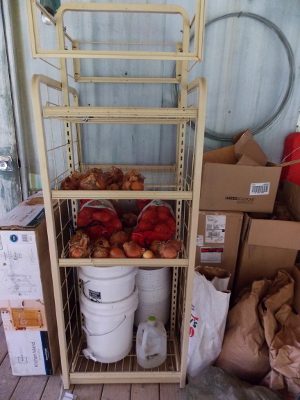 came home with me, and I quickly assembled it
and determined the rack was the best thing since sliced
bread. The wheels are still out in the car, but once we dig
them out, the unit will even be rollable and easy to move inside
if a sudden frost threatens.
came home with me, and I quickly assembled it
and determined the rack was the best thing since sliced
bread. The wheels are still out in the car, but once we dig
them out, the unit will even be rollable and easy to move inside
if a sudden frost threatens.
I think Jayne has
more of these display units looking for a home, and if so, I plant
to add more racks to each individual unit. For drying
purposes, I could easily fit about eight levels in one unit and
barely use up any floor space at all. Since the shelves are
removable, it'll be easy to change the distance between racks when
the time comes to pull in the butternuts and then the sweet
potatoes.
In the meantime, our
storage onions are finishing up the curing process in their new
home. Most are fully dried and bagged, but the ones that
seemed to need a bit more time (or to be eaten sooner) are now
laid individually on the rack surface for more even drying.
Thanks so much, Jayne and Rose Nell, for the world's best drying
rack!
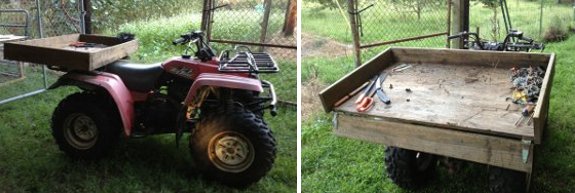
One of our readers sent us
some photos of his ATV modifications.
Tim says he can take it off
easily when needed, but might make it a little more narrow to avoid
snagging.
A surface area like that
would make hauling broken bales of straw a little easier. Maybe I could
use part of our Bucket Hauler for something like this?
Want more in-depth information? Browse through our books.
Or explore more posts by date or by subject.
About us: Anna Hess and Mark Hamilton spent over a decade living self-sufficiently in the mountains of Virginia before moving north to start over from scratch in the foothills of Ohio. They've experimented with permaculture, no-till gardening, trailersteading, home-based microbusinesses and much more, writing about their adventures in both blogs and books.


